Un magnifique alto de Nicolas Lupot sera proposé lors de la vacation du 1er juin 2023 à Vichy. Le luthier bâlois Roland Baumgartner disait lors d’une conférence en 2000 : “On connait peu d’alto de Nicolas Lupot. Cet instrument de 1808, est à ma connaissance, le meilleur exemple qui soit.”
Un article de Lothaire MABRU
Professeur émérite, Université de Bordeaux Montaigne
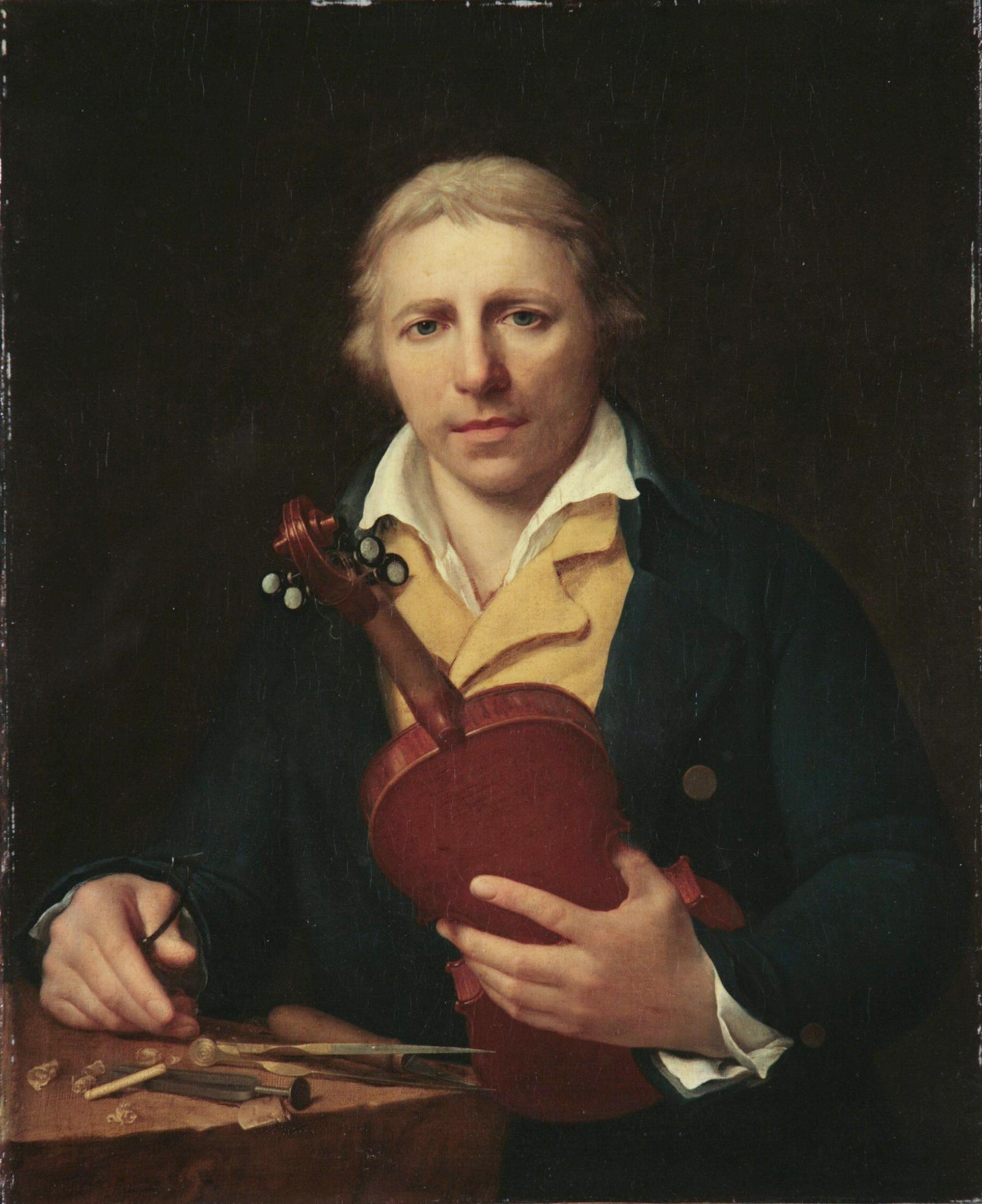
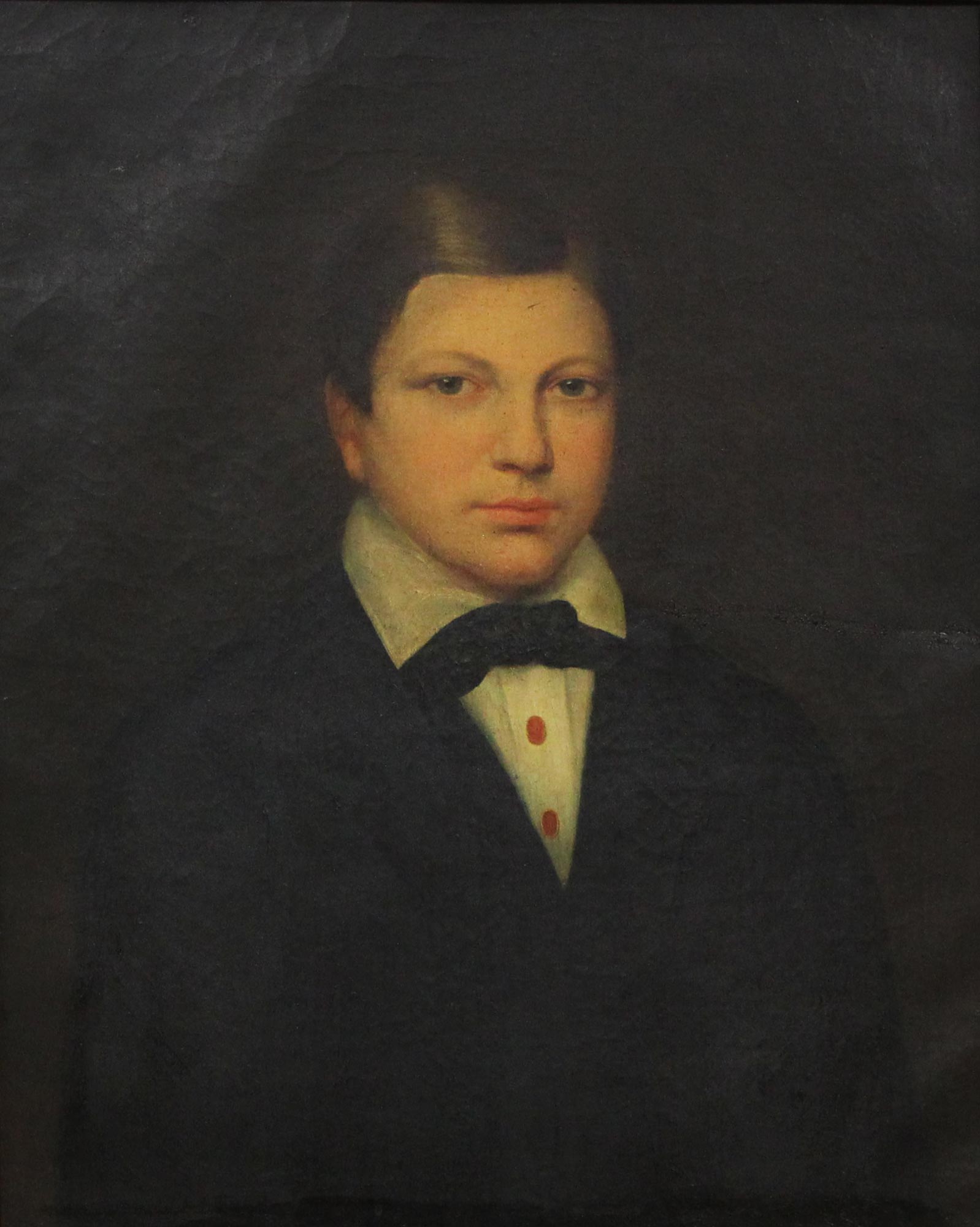
Regardons le tableau peint en 1805 par Henriette Lorimier (1775-1854) montrant Nicolas Lupot dans son atelier. Le luthier occupe tout le tableau, on ne note pas la présence de quelque artifice destiné à montrer le statut social de l’artisan, si ce n’est l’habit qui dénote une certaine aisance matérielle. L’important ici se manifeste dans un triangle (référence franc-maçonne ?) constitué de ses deux belles mains, aux doigts longs et fins, et de son visage. La physionomie montre une certaine concentration, et en même temps un homme à l’heureux caractère qui exerce un métier qui le passionne. L’une de ses mains tient un violon fini, en cours de réglage, et objet de toutes ses attentions. Sa main droite tient un outil, et devant elle, posés sur l’établi, une âme, un compas, et un diapason achèvent la description. Tout est dit, rien n’est superfétatoire : on va à l’essentiel. Cela fait tout le charme et l’élégance de ce tableau, y compris le fond noir qui met en valeur le luthier.
Lupot fut aussi le maître d’apprentissage de Charles François Gand (1787-1845), qui deviendra son successeur. Un second tableau, peint la même année que le premier, représente Gand à 18 ans. Sans pour autant en avoir la certitude totale, on peut supposer que Lupot a profité de la présence d’Henriette Lorimier, pour lui demander de faire le portrait de celui qu’il chérissait déià comme son meilleur élève.
Mais qui donc est ce luthier ? Ni plus ni moins que le plus grand luthier français non seulement de son temps mais aussi pour la postérité. D’ailleurs, ne l’a-t-on pas surnommé le Stradivarius français ? La comparaison élogieuse le relègue au second rang, car l’indétrônable luthier crémonais sera pour l’éternité le paradigme de la profession. Mais Lupot ne fut en aucun cas un copiste servile de Stradivarius, car s’il vouait une grande admiration envers Stradivarius, il a su garder sa personnalité, en ne le copiant pas mais en faisant une synthèse de ses travaux.
Bien que Lupot soit né à Stuttgart, l’origine de sa famille se trouve en Lorraine, comme bon nombre de luthiers français, et il peut revendiquer une ascendance dans la lutherie, avec son grand-père Laurent (1696-1771), puis son père François (1725-1805), dit François I car Nicolas avait un frère- prénommé François -donc dit François II- (1774-1838) qui fut un archetier renommé. Installé à Lunéville, François I sent le vent tourner et profite d’une occasion pour partir en 1758 à la cour du Duc de Wurtemberg installée à Stuttgart, où il occupe la charge de luthier de la cour. C’est là que naitra Nicolas le 4 décembre de cette même année. Dix ans plus tard, les dépenses sans compter du duc, ainsi que son attirance pour les jupons des chanteuses, font scandale et il doit licencier.
François I se voit notifier l’arrêt de son contrat, et part s’installer à Orléans, où quelques années plus tard Nicolas deviendra à son tour luthier. Il franchit toutes les étapes nécessaires pour devenir luthier : apprentissage auprès de son père, puis son collaborateur.
Les violons de Lupot père suivent le modèle en vogue à son époque, celui de Stainer, principalement. Mais il a vu passer des Stradivarius à la cour de Stuttgart, et à la fin de sa carrière, les instruments faits en collaboration avec son fils, commencent à s’inspirer du célèbre italien, sans pour autant aller aussi loin que ceux produits ultérieurement par Nicolas. Mais le processus est en marche et va prendre quelques temps pour aboutir aux chefs-d’œuvre de son fils.
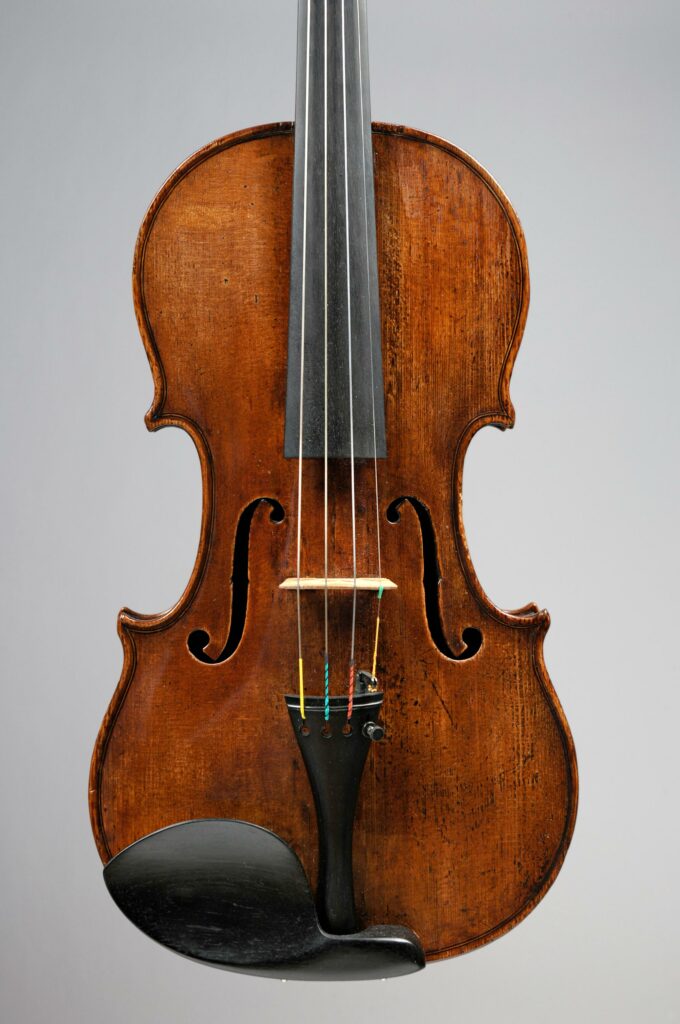
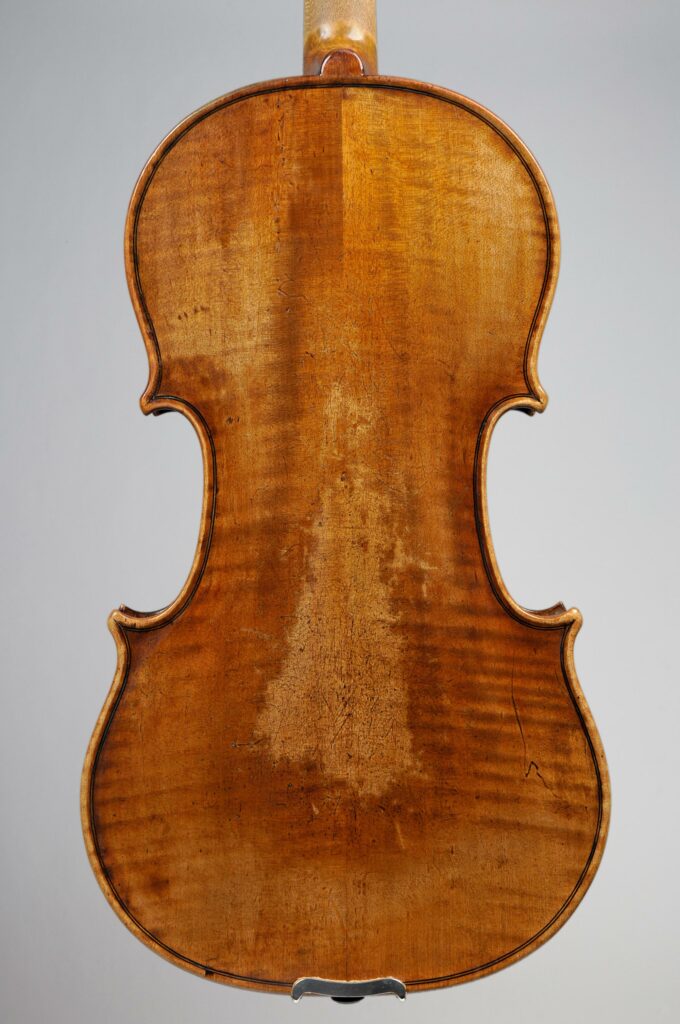
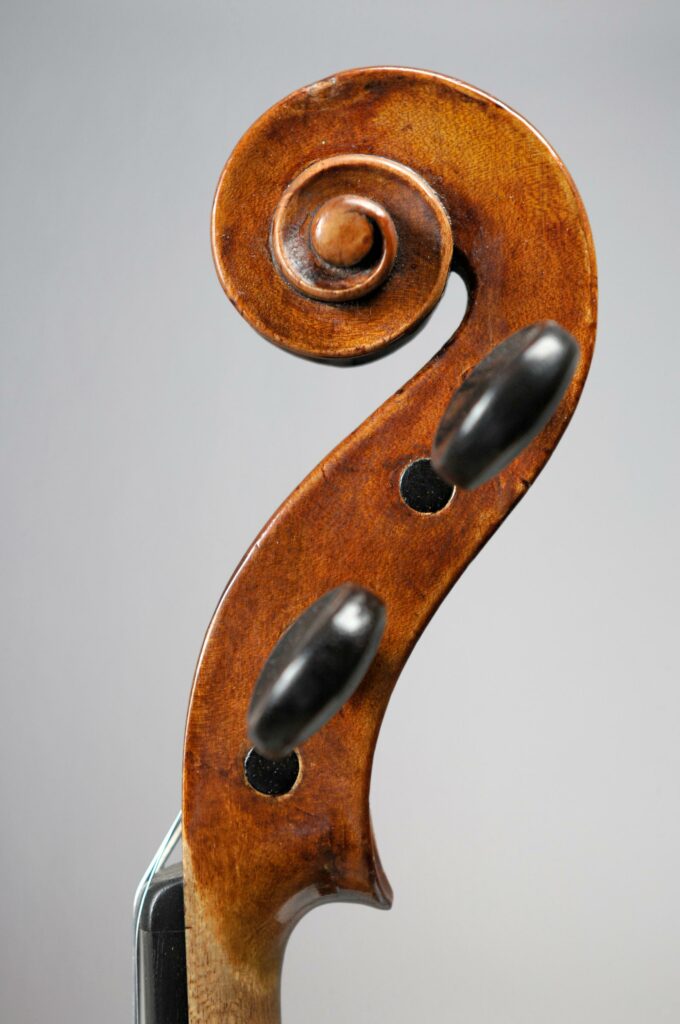
Violon de François LUPOT fait à Orléans vers 1775-1780
Instrument mis en vente par Vichy Enchères le 5 décembre 2013 © C. Darbelet
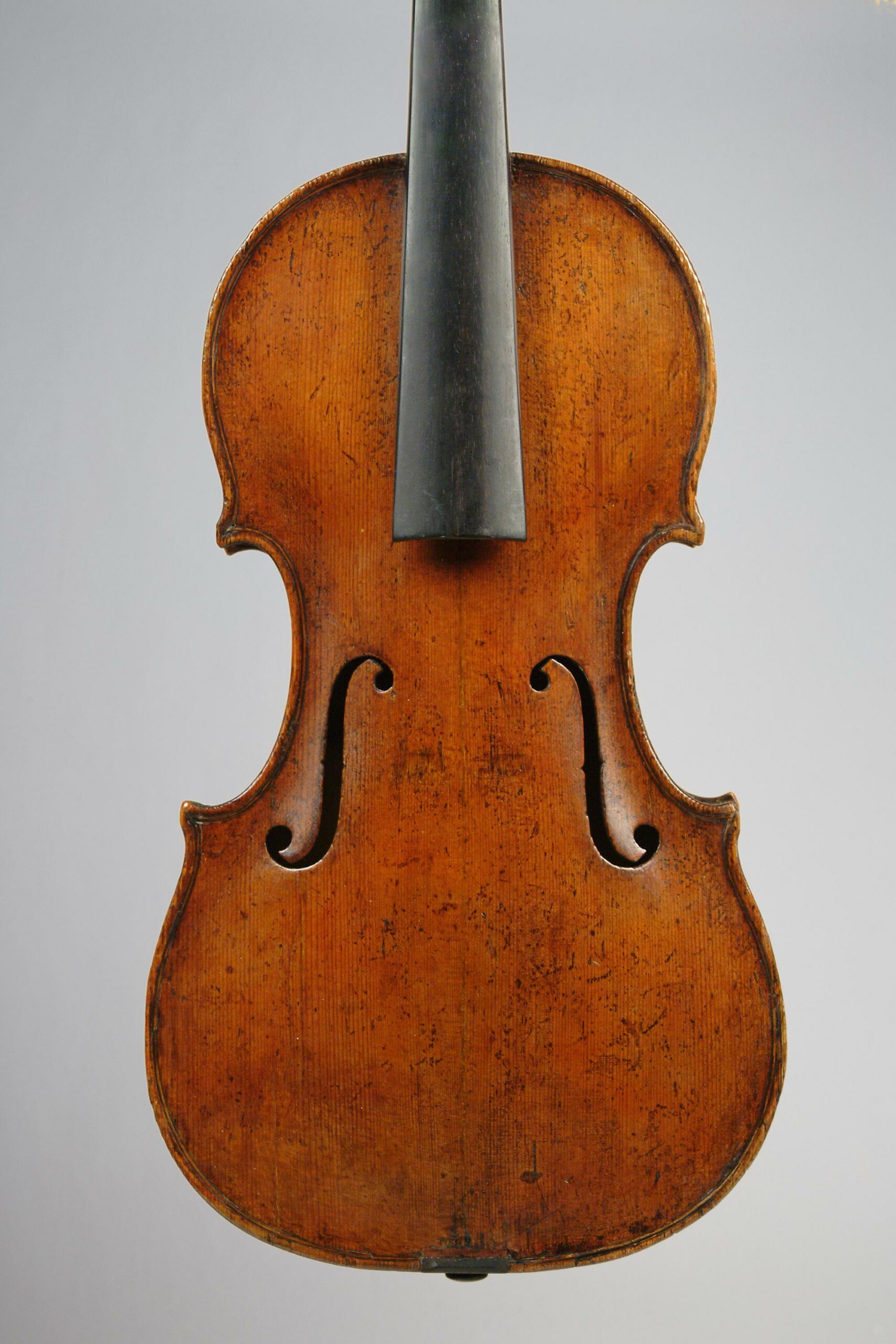
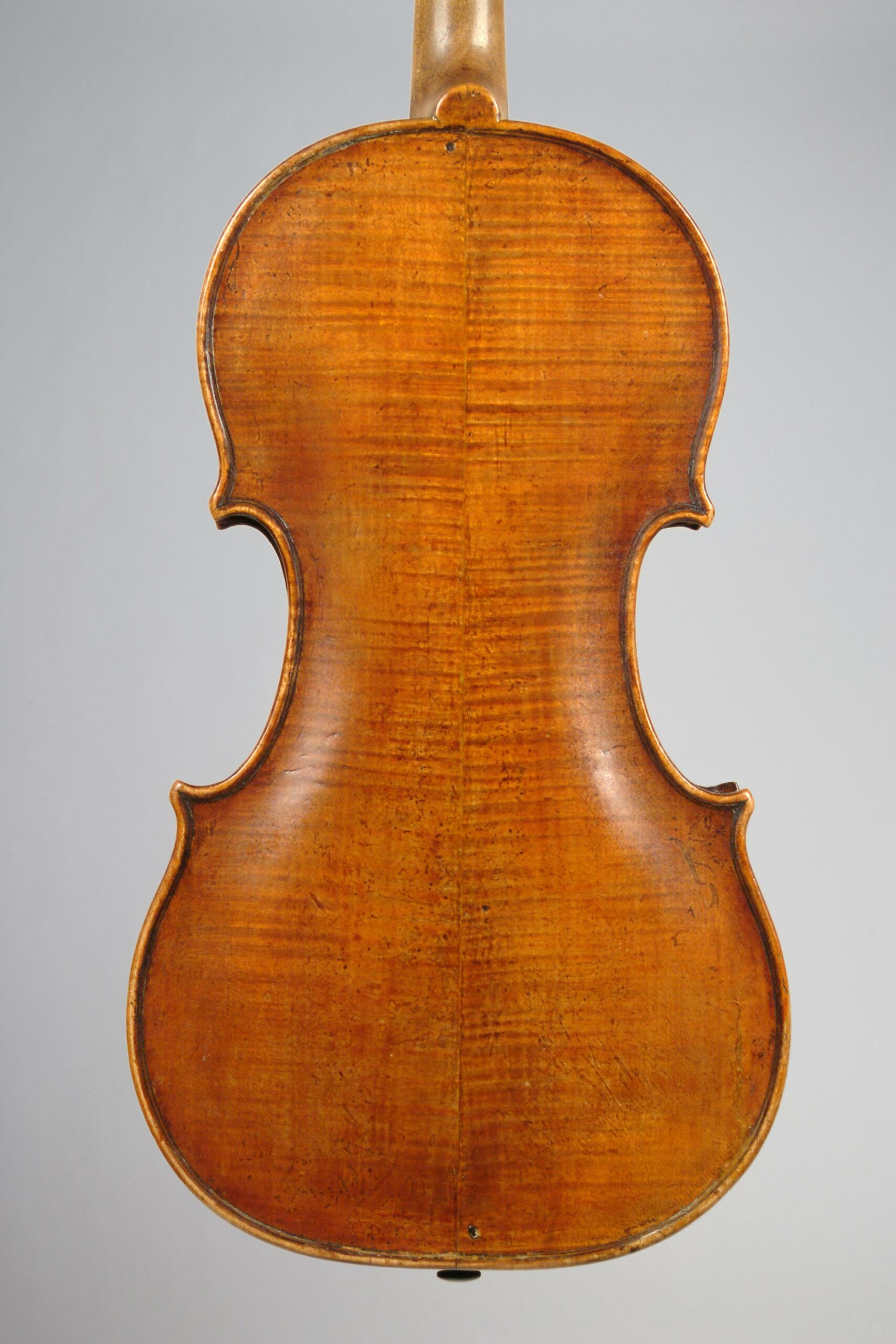
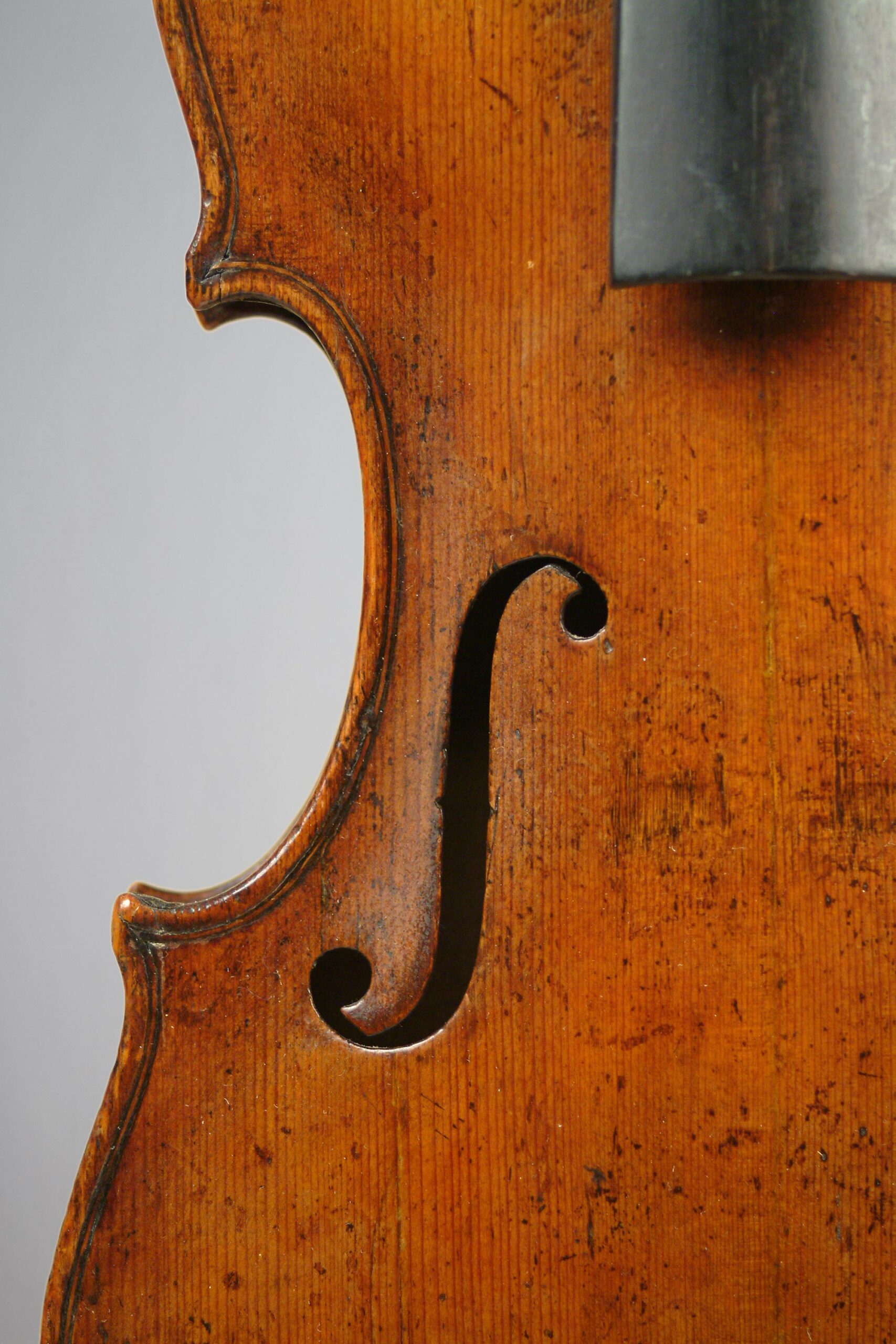
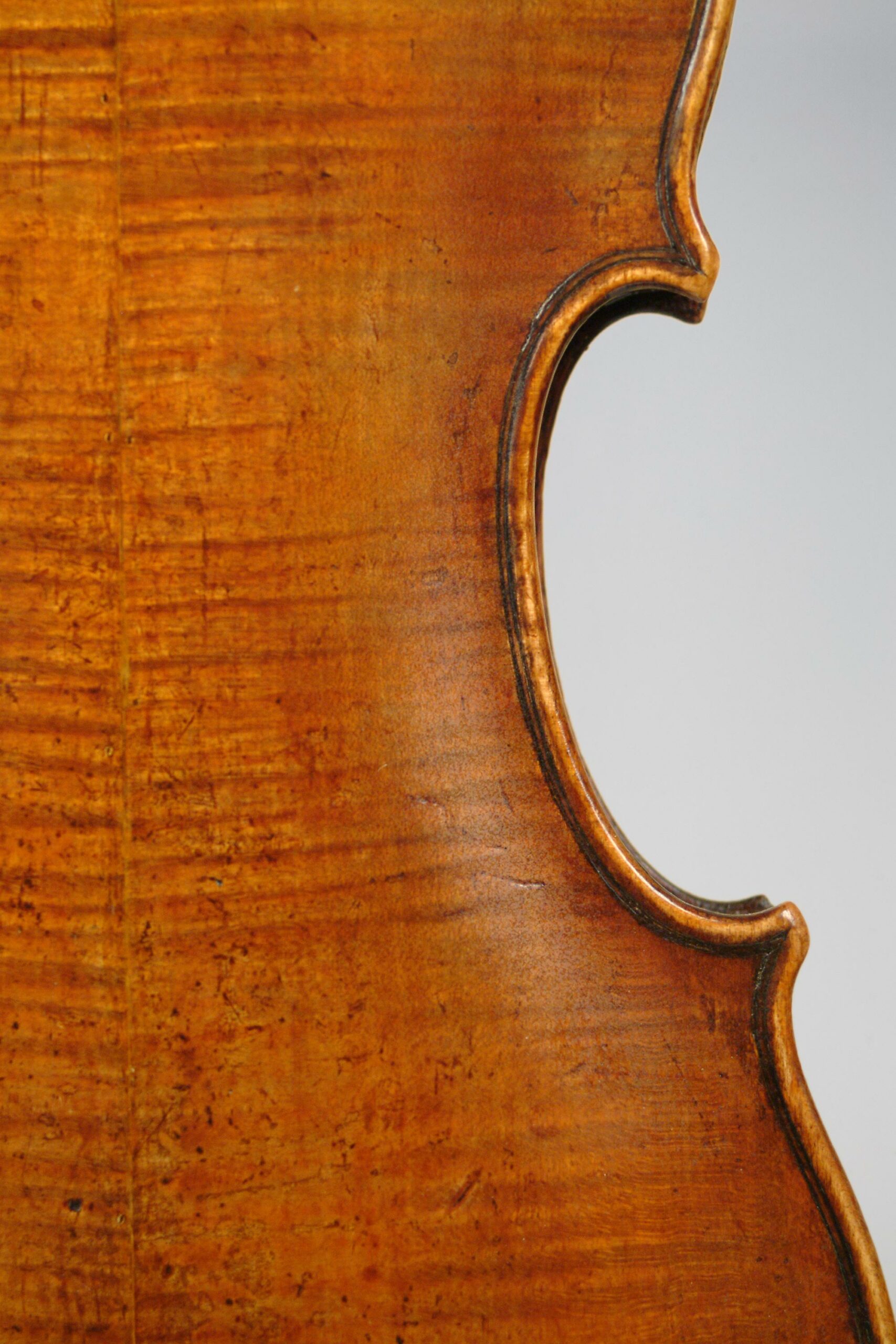
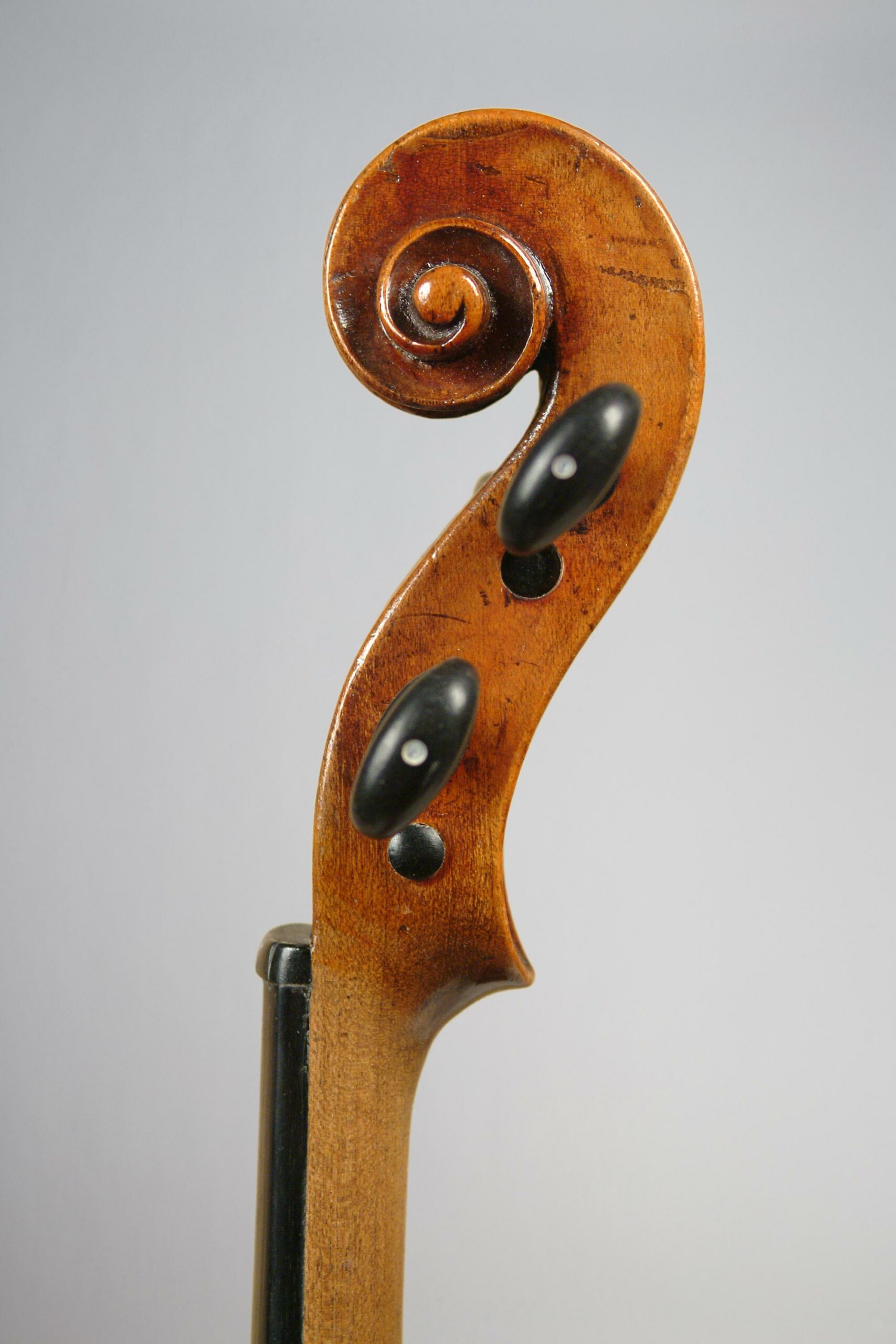
Violon de François LUPOT fait à Orléans vers 1775
Instrument mis en vente par Vichy Enchères le 3 juin 2004 © JH Bayle
Enfin il s’installe à son compte rue d’Illiers à Orléans en 1781. Il restera jusqu’en 1796, année de son installation à Paris. Cette première période de production le voit tout d’abord inscrire son travail dans la continuation du modèle paternel, mais dès 1792 il entre en relation avec Louis François Pique (1758-1822) qui l’influence en orientant son attention vers Stradivarius. Lupot doit maintenant fort bien maîtriser sa main, car Pique lui commande des violons en blanc qu’il vernira, et dans lequel il apposera sa propre étiquette.
Lorsqu’un tel fait se produit, l’artisan qui fabrique doit suivre le modèle et les consignes de celui pour lequel il travaille, sinon ce dernier ne pourrait pas l’assumer en y inscrivant son nom. Cette expérience permet à Nicolas Lupot d’évoluer vers une production tournée vers la lutherie de Stradivarius qui prend à cette époque beaucoup d’importance chez les luthiers parisiens, lesquels travaillaient auparavant sous l’influence de Stainer et d’Amati. En d’autres termes, Lupot s’affranchit du passé et prend conscience de ses possibilités.
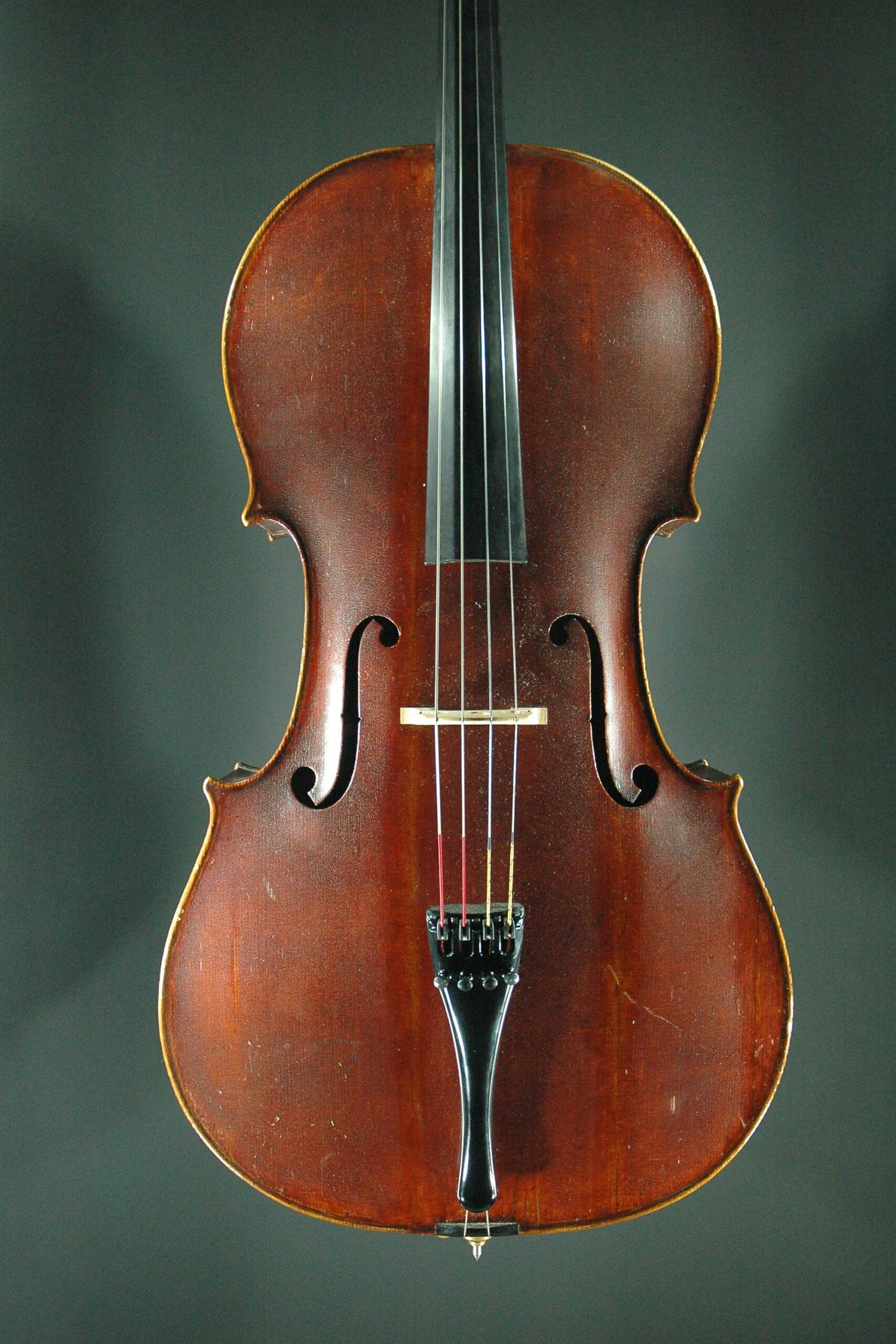
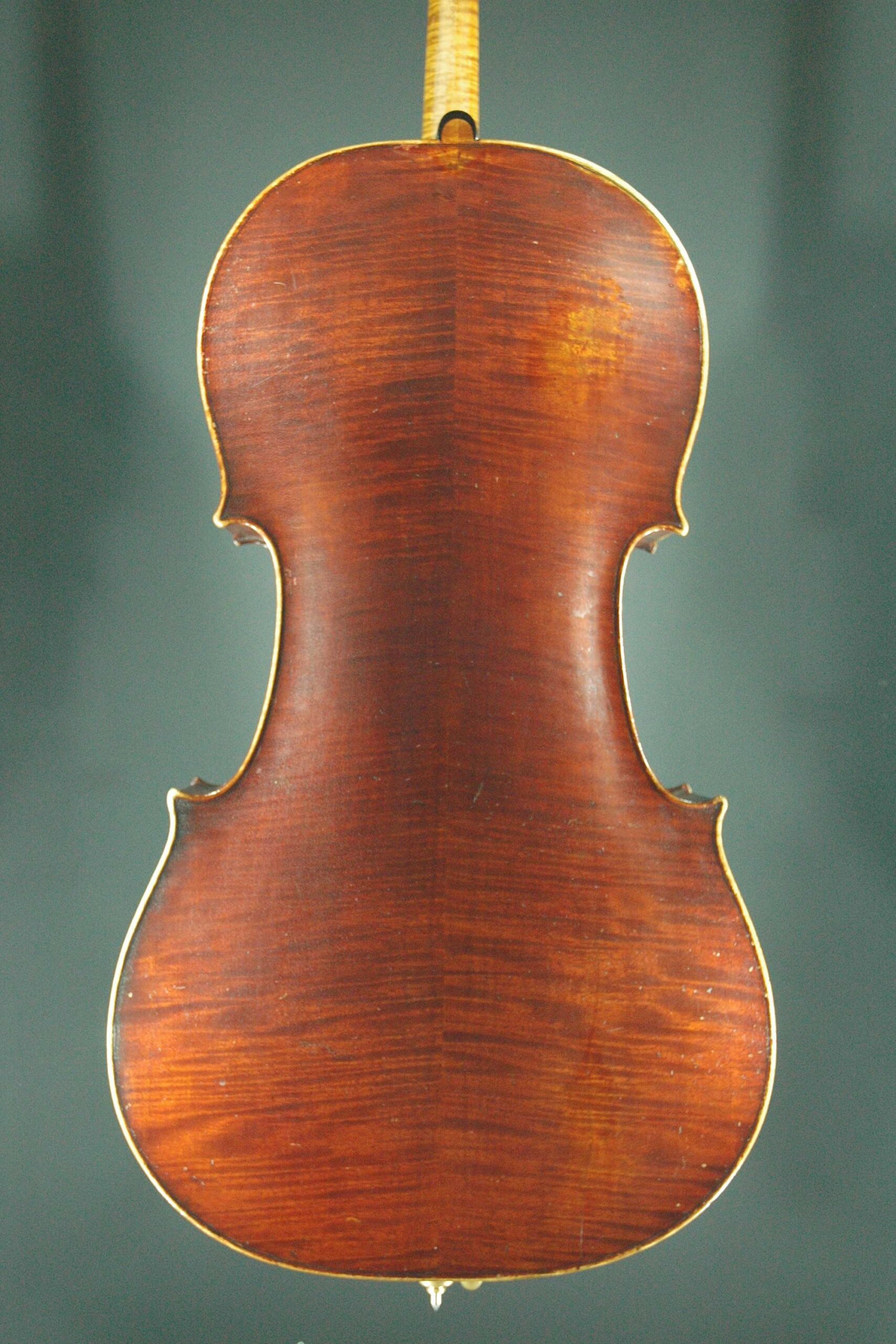
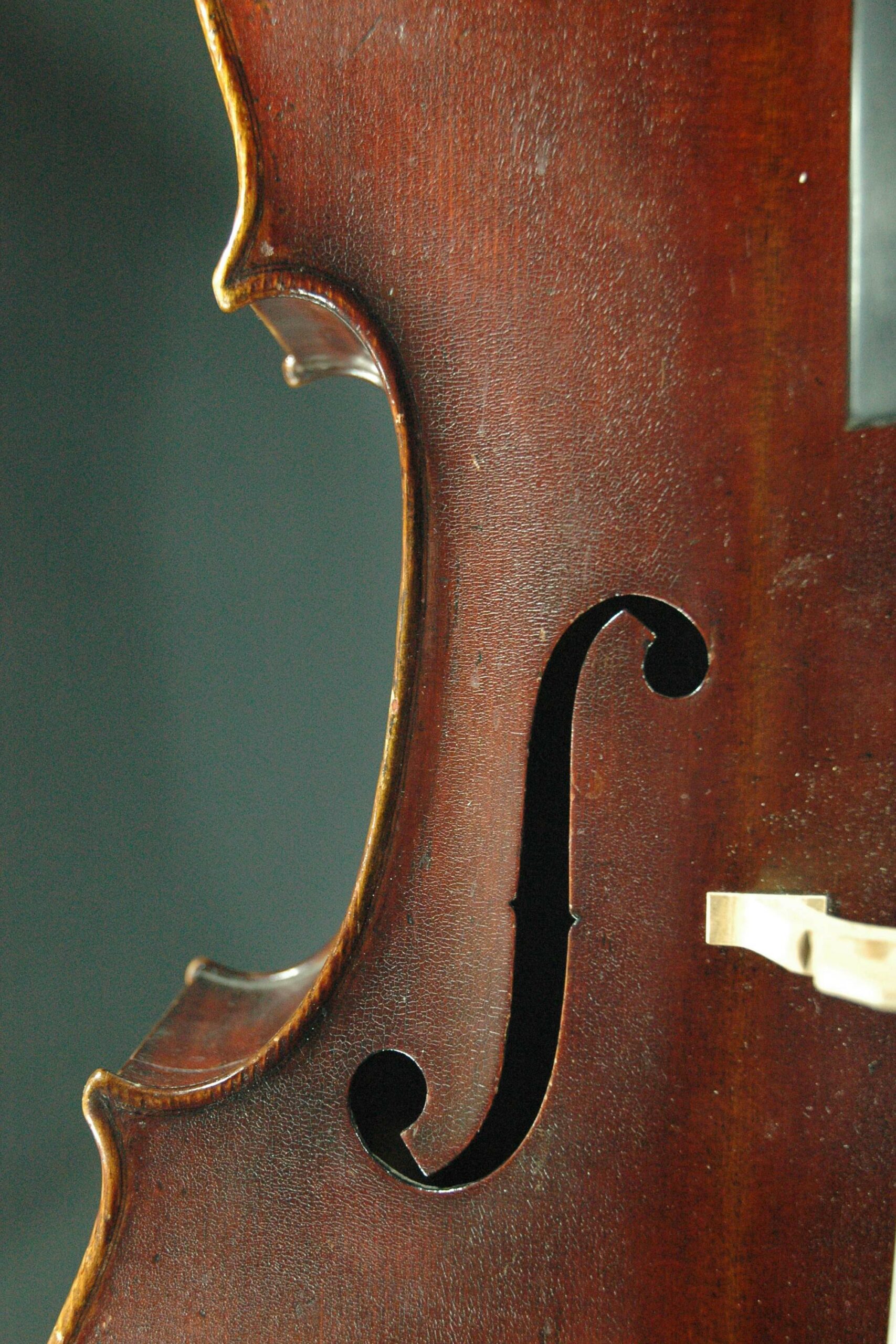
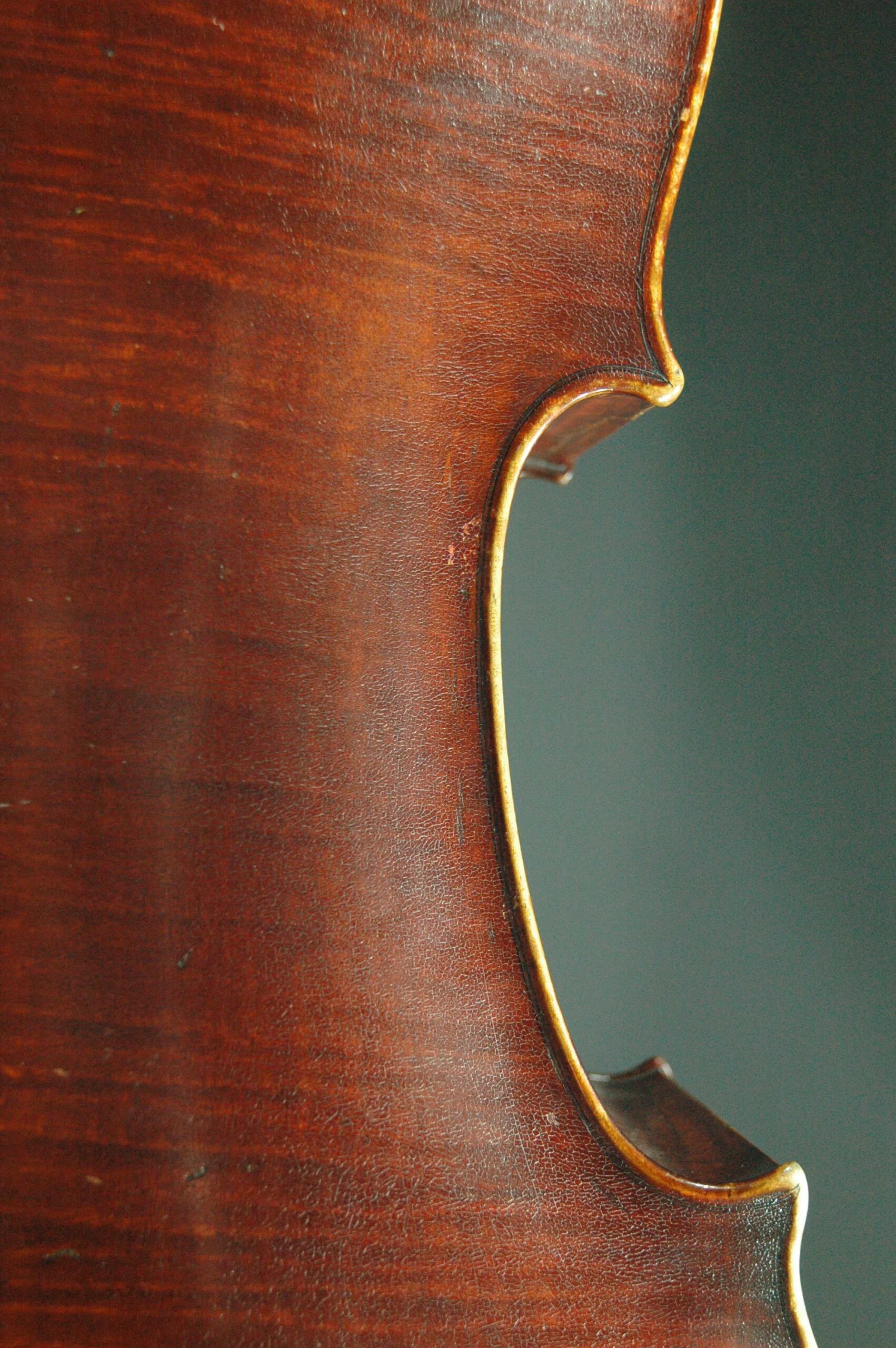
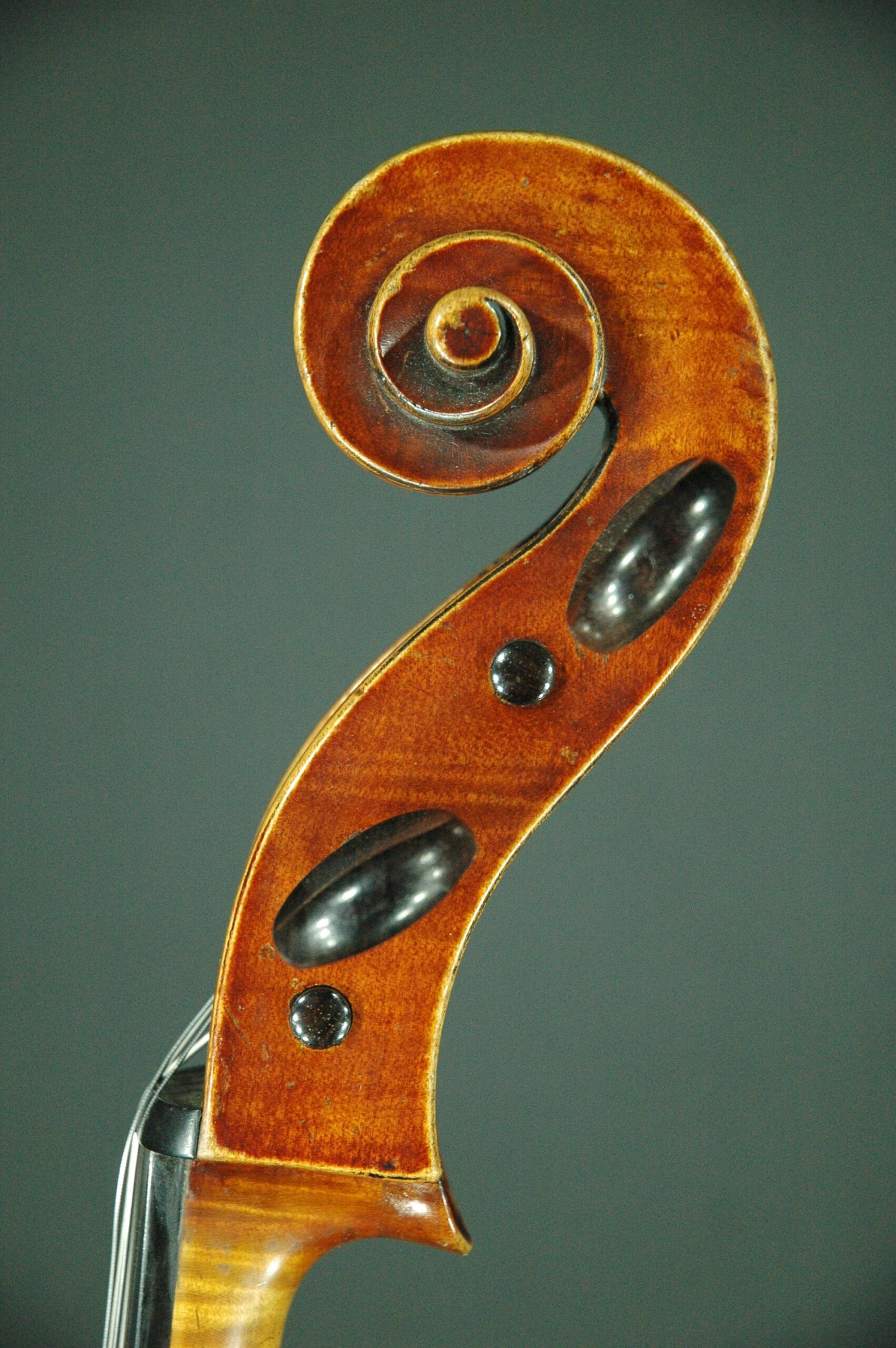
Violoncelle de Nicolas LUPOT fait à Orléans vers 1792/1793
Instrument mis en vente par Vichy Enchères le 3 décembre 2009 © Maison Vatelot Rampal
La violoniste néerlandaise Myrthe Helder parle et joue de son violon de Lupot de la fin du XVIIIe siècle :
« J’ai joué de nombreux instruments dans ma vie, mais ce n’est que maintenant que j’ai l’impression d’avoir trouvé l’âme sœur. Ce Lupot est un violon brillant, grand, dur, mais aussi très beau et poétique. Il possède des qualités insensées, s’élevant sans problème au-dessus d’un orchestre entier (…). J’ai eu des Stradivarius entre les mains et je préfère encore ce Lupot ! ».
L’installation à Paris permet à Nicolas d’enrichir ses connaissances en côtoyant les meilleurs musiciens qui jouent de beaux et bons violons. L’homme ausculte les instruments, analyse, prend des notes et met en œuvre les connaissances ainsi acquises dans sa facture. Mais pas seulement : il veut aussi proposer une synthèse de ses travaux.
Celà sera fait grâce à l’abbé Sibire qui publie en 1806 « La Chélonomie ou le parfait luthier », à partir des notes de Nicolas Lupot, jamais nommé, mais qui est le véritable auteur du livre, l’abbé l’ayant mis en forme et rédigé. Sylvette Millliot considère à juste titre la Chélonomie comme « une véritable révolution esthétique ». (2015, vol. 2 p. 32).
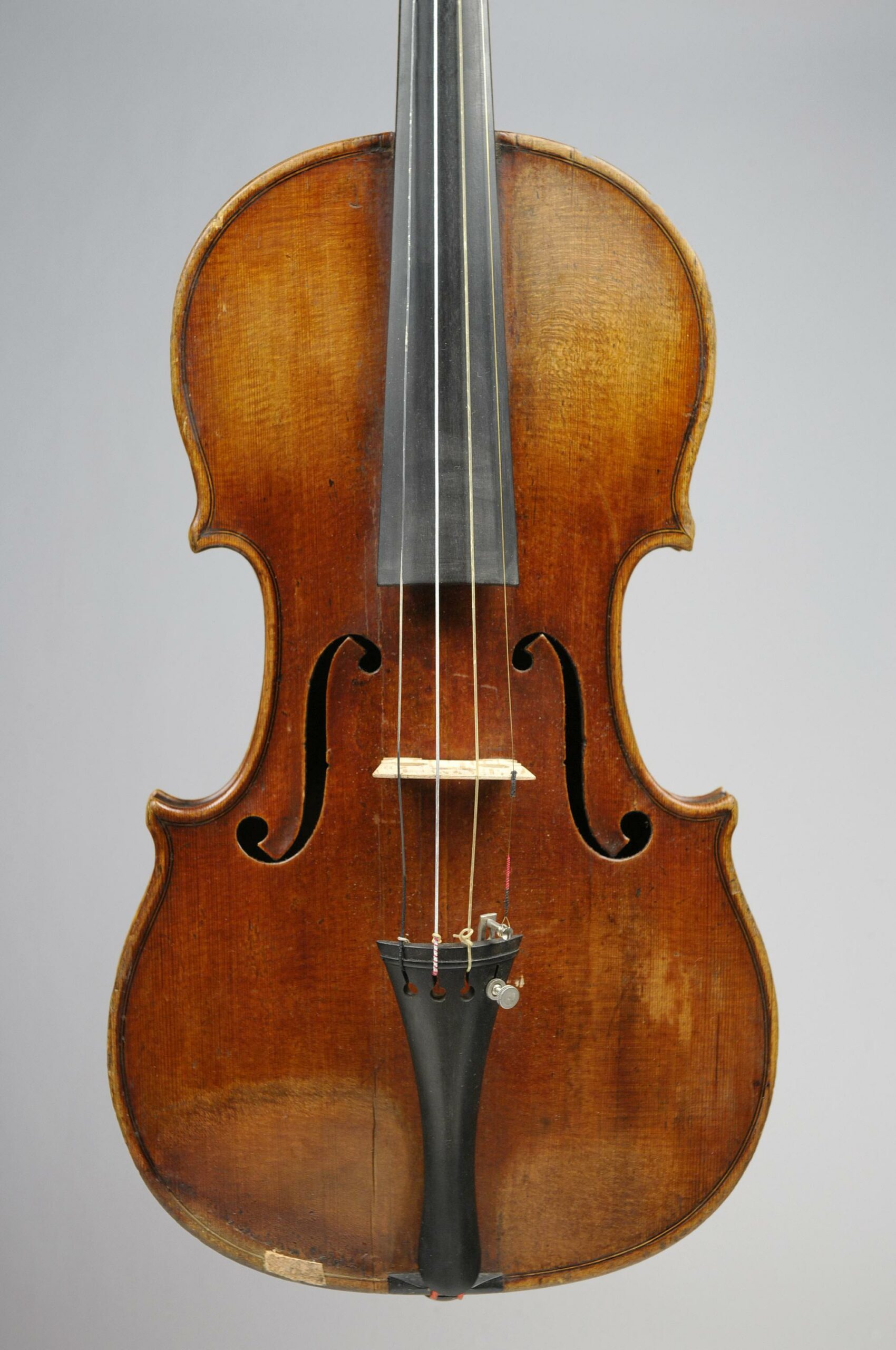
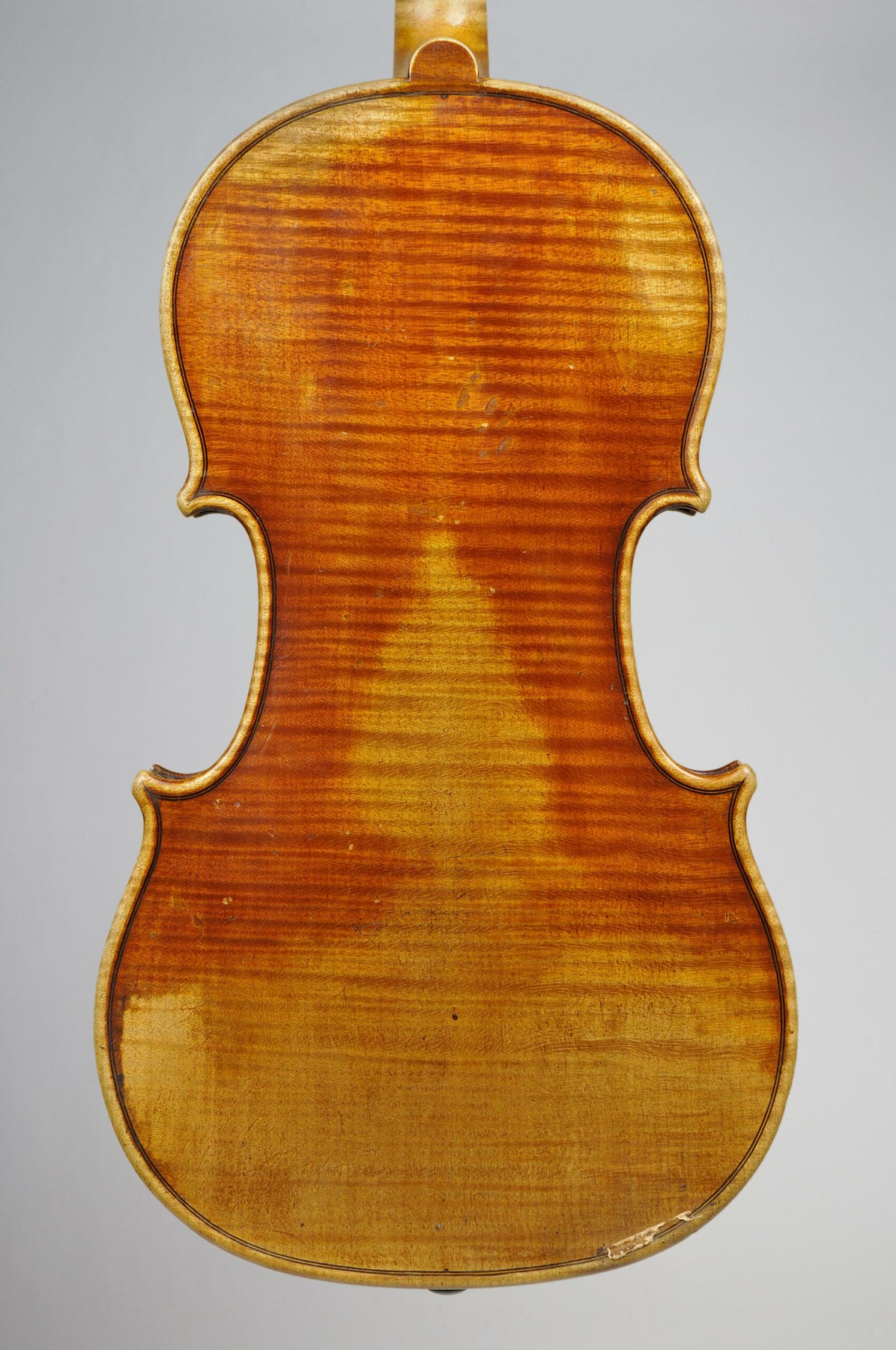
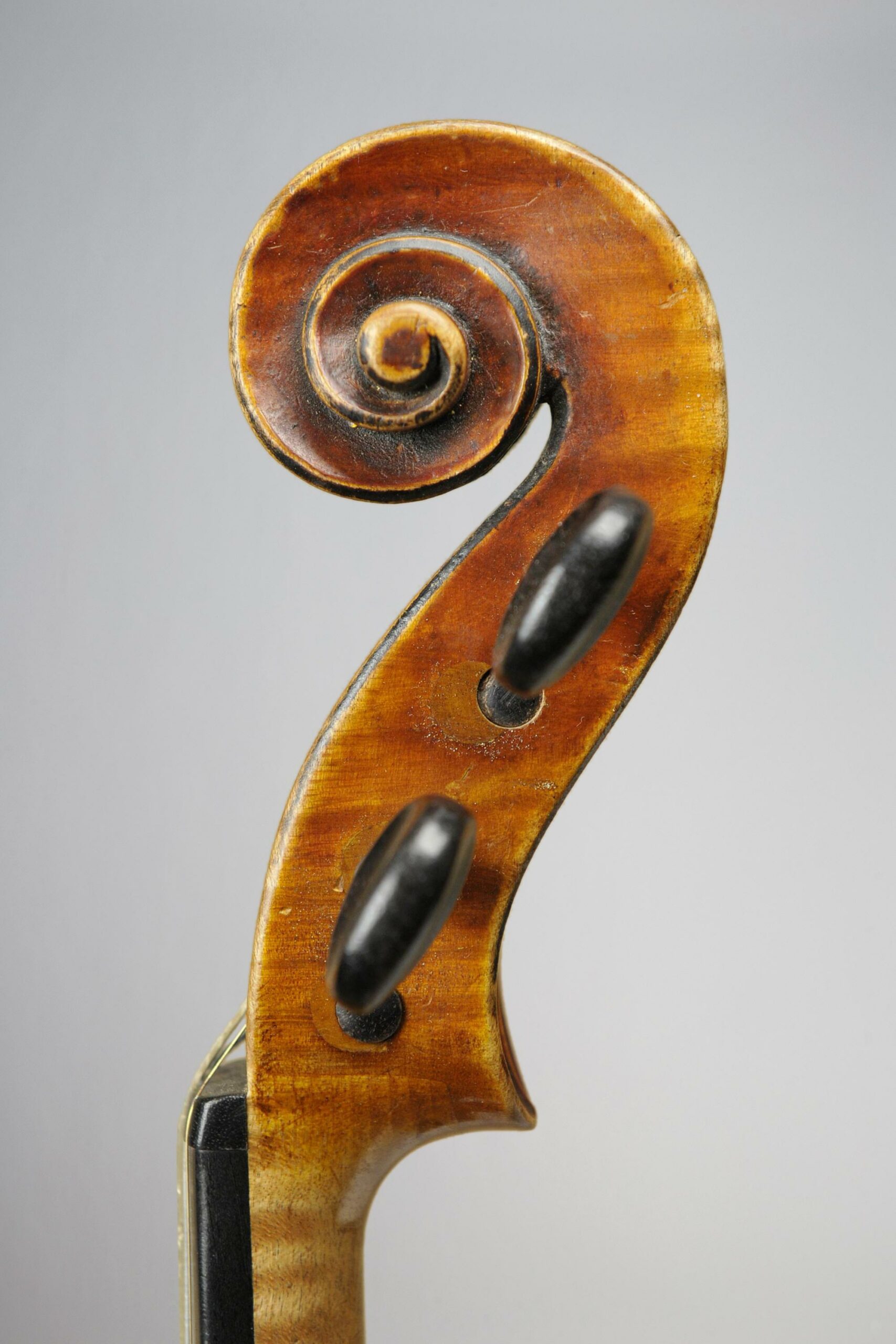
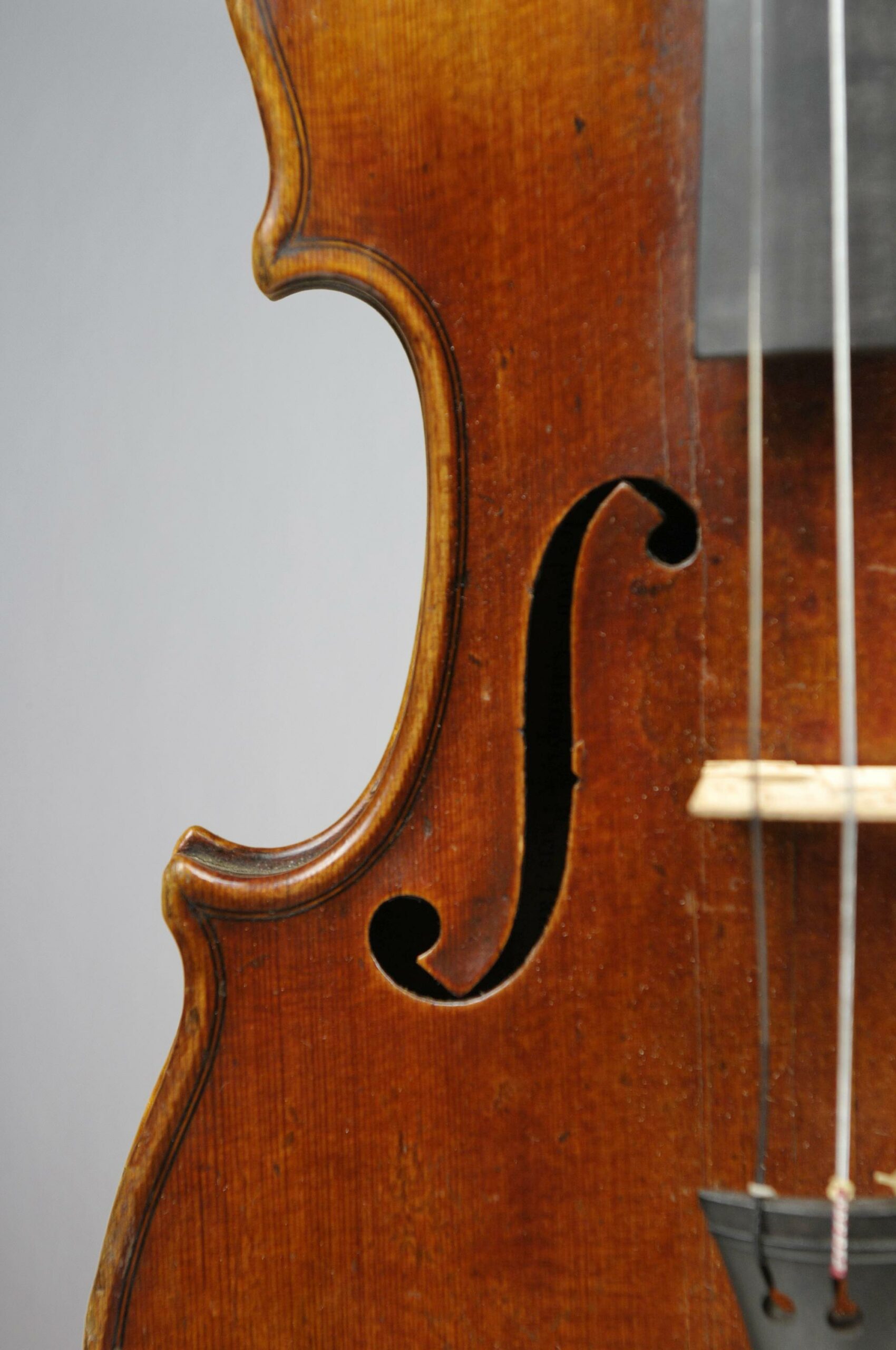
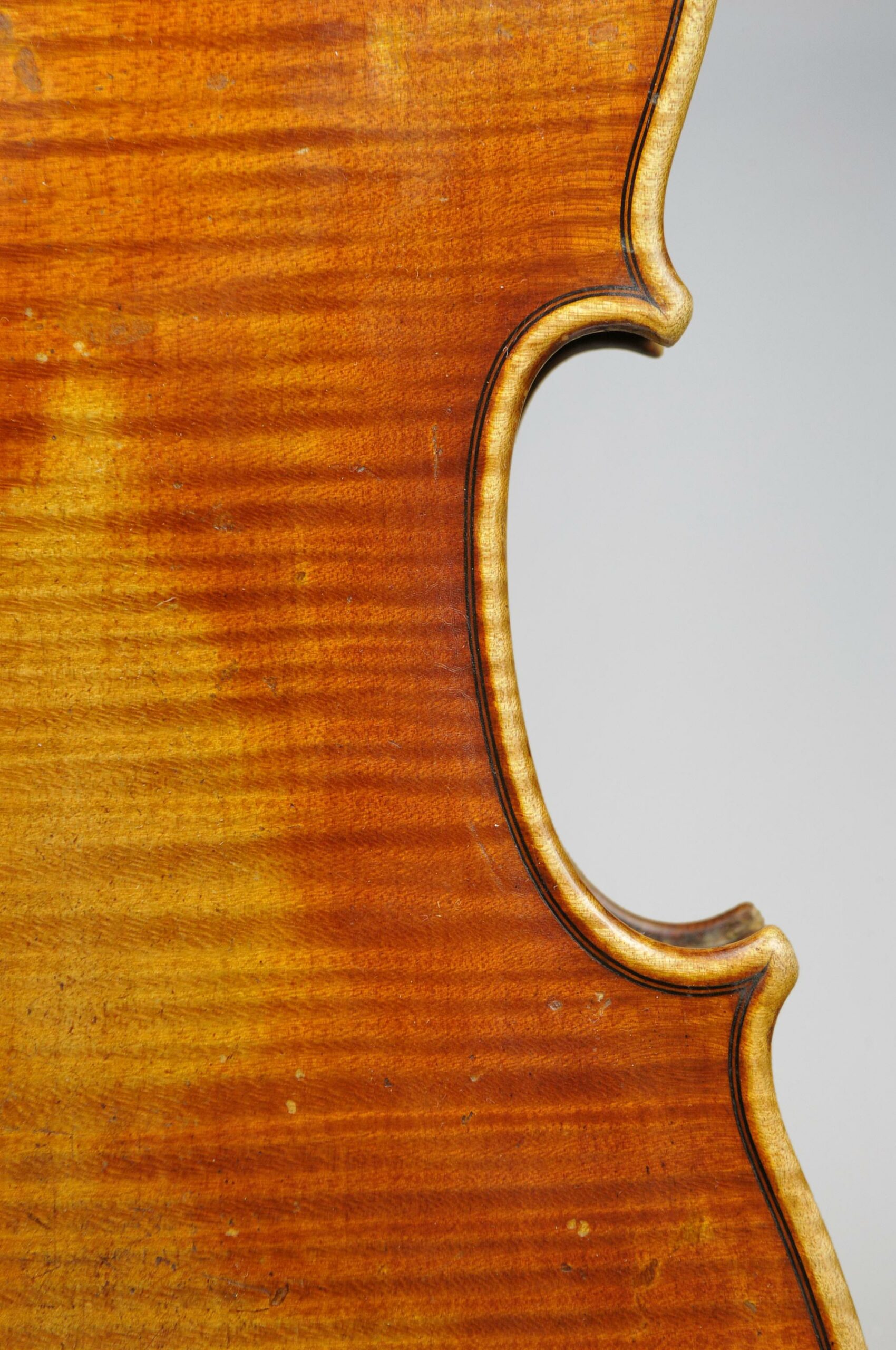
Violon de Nicolas LUPOT fait à Paris au millésime de 1804
Instrument mis en vente par Vichy Enchères le 3 juin 2010 © Maison Vatelot Rampal
Quant à l’absence du nom du luthier sur et dans le livre, il y a de quoi s’interroger :
« Est-ce par une modestie exagérée que l’habile facteur de violons n’a pas inscrit son nom sur le titre du livre ? A-t-il craint, en s’en déclarant l’auteur, que le public condamnât l’ouvrage sans le lire et le considérât comme une oeuvre à vues étroites, personnelles, ou comme une réclame de fabricant ? En n’y mettant que le nom de l’abbé Sibire, a-t-il voulu donner à l’opuscule une portée plus large, plus générale, moins individuelle en un mot cherchait-il, par cet innocent et bien pardonnable subterfuge, à se dérober aux attaques de la jalousie, de la rivalité, de la haine, car si Lupot avait ses amis et ses admirateurs, il avait aussi, en bien plus grand nombre, hélas ! ses ennemis et ses détracteurs ?
Toutes ces suppositions sont permises, mais la dernière parait la plus fondée. Lupot était un studieux, un penseur, un inquiet, un inventeur, et, comme tous les hommes qui cherchent et qui trouvent, il a été en butte aux mille traits de la médiocrité et de la routine ».
Ainsi s’exprime le rédacteur de la notice introductive à l’édition de 1885, L. de Partis, qui nous permet de mieux connaitre le luthier.
Le succès arrive inévitablement, et peut se mesurer au fait qu’à partir de 1797 le Conservatoire lui commande un violon qui doit être offert au premier prix, tradition qui va durablement s’installer et perdurer avec les Gand, Gand et Bernardel notamment, successeurs de Lupot.
Le déplacement de l’atelier de Nicolas Lupot dans la rue Croix-des-petits-Champs inaugure ce que l’on nomme la période dorée du luthier, durant laquelle il fera ses plus beaux instruments, même si vers la toute fin, la vieillesse se faisant sentir, la main s’assagit et s’alourdit un peu. Charles François Gand va le quitter pour retourner à Versailles, puis prendre la succession de Koliker à Paris en 1819, et enfin en 1824, celle de Lupot, son maître et beau-père de cœur.
La reconnaissance institutionnelle va s’amplifier puisqu’en 1813 il reçoit le titre de « Luthier de Sa Majesté L’Empereur », puis celui de « Luthier de la Chapelle Royale de sa majesté l’Empereur et le Roi ». Ces titres et charges ne sont pas données à la légère, on l’imagine aisément, mais officialisent la reconnaissance de son travail.
Non seulement la production de Lupot peut s’enorgueillir d’être la meilleure et la plus belle de son temps, mais le luthier inaugure une « école de lutherie » qui va perdurer tout le long du XIXe siècle. Car il a formé Silvestre, Gand mais aussi Bernardel Père, qui eux-mêmes transmettront le flambeau à leurs fils respectifs, qui, de surcroît vont s’associer sous l’intitulé de Gand et Bernardel, poursuivant ainsi la tradition élaborée par Lupot, tout le long du XIXe siècle. Autrement dit l’œuvre de Nicolas Lupot ne saurait se réduire à sa seule facture d’instruments, ce qui serait déjà beaucoup : le mérite lui revient d’avoir permis à la lutherie française du XIXe siècle de surplanter la lutherie italienne, qui décline à cette époque. Si, en effet il est incontestable que la lutherie italienne domine le XVIIIe siècle, la lutherie française domine le siècle suivant.
Un magnifique violon de 1811
John Dalley du fameux quatuor Guarneri, en compagnie de Michael Tree, David Soyer, et Mikhail Rudy, joue le quatuor en sol mineur de Brahms. John Dalley tout comme ses confrères du quatuor Guarneri, s’est vu proposer un Stradivarius. Ils ont tous refusé !
On pourrait citer nombre de commentaires élogieux sur Lupot, de musiciens et d’auteurs d’ouvrages sur la musique de différentes nationalités. Celui du compositeur, violoniste virtuose et pédagogue allemand Ludwig Spohr (1784-1859), permet de comprendre en quelle estime sont tenus les instruments de Lupot. Dans sa méthode de violon de 1832, il place sur un pied d’égalité les instruments de Pique et de Lupot avec ceux de Stradivarius, Guarnerius et Amati. Dans son Dictionnaire des Luthiers, Willibald Lutgendorf écrit à propos de Spohr : « Depuis qu’il a acheté un violon de Lupot, il joue exclusivement sur celui-ci ». (1922, p. 307).
Pour Antoine Vidal, Lupot est l’initiateur et le chef de file de la lutherie française du XIX° siècle. : « Nous n’avons connu en France, pendant tout le XVIII° siècle que des instruments de second ordre ; et, jusqu’au moment où Nicolas Lupot vint s’établir à Paris, nous sommes restés dans un état d’infériorité trop réel. Mais lorsque ce dernier commença à travailler sérieusement, une sphère nouvelle s’ouvrit pour nous, et l’époque brillante de la lutherie française s’annonça, pour aller grandissant, jusqu’au moment actuel. » 1876, tome premier p. 152.
L’anglais Georges Hart confirme ce point de vue « Lupot n’a point eu de rival de son temps ; personne, depuis lui, n’a pu égaler ses productions. Disons-le hardiment, Lupot est le roi des luthiers modernes, et ses instruments ne font que gagner à mesure que le temps s’écoule. Son vernis lui est tout particulier. Il est de bonne qualité et d’une pâte délicate. Bien qu’il ne participe pas du vernis italien, il s’éloigne également aussi de la nature du vernis qu’on trouve sur les violons de ses contemporains ; on peut donc le définir comme un vernis qui tient le milieu entre un vernis italien et un vernis français. Sa couleur varie du rouge clair au rouge brun. Le temps a augmenté son éclat, et quoiqu’il soit vrai de dire qu’il ne prendra jamais la place des vernis de Crémone, il tiendra cependant la première place parmi les vernis modernes ». (1886 p. 211-212).
De plus, il faut bien constater que cette première place accordée à Nicolas Lupot, lui reste définitivement acquise. Dans la littérature plus récente, les éloges perdurent. Ainsi William Henley dira de lui, dans son dictionnaire, qu’il « est devenu le plus grand génie français » (1973 : p. 727). Et René Vannes, lui aussi auteur d’un dictionnaire des luthiers devenu un classique, n’hésitera pas à dire que « son travail ne laisse rien à désirer ; la main d’œuvre est parfaite et ne peut être surpassée. La sonorité est jolie, pas très éclatante, mais ronde et portant bien ». (1999 : p. 219).
Ce bel Alto de Nicolas Lupot, daté de 1808, donc de sa période de production dite dorée, présente toutes les caractéristiques de son œuvre. Un vernis rouge orangé sur fond jaune recouvre l’instrument, lequel a semble-t-il beaucoup plu aux musiciens successifs qui l’ont joué, car le vernis jaune apparaît en maints endroits de l’instrument. Le fond est d’une pièce d’érable aux ondes moyennes à fines, montant de gauche à droite. Deux chevilles, posées au niveau des tasseaux du haut et du bas en consolident le collage et font comme deux grains de beauté à cet alto. Sur la table on remarquera aussi la terminaison des onglets en bec de corbeaux, qui non seulement montrent la sureté de la main du luthier, mais aussi offre un charme supplémentaire à l’instrument. La table d’une seule pièce présente un léger chenillage, particulièrement apprécié par Lupot, et qui selon les acousticiens procure une qualité sonore certaine. Le modèle s’inspire fortement de Stradivarius -comme souvent chez ce luthier- mais reste personnel. La tête, réalisée selon le modèle du violon et non du violoncelle (avec décrochement) comme cela arrive souvent pour les altos, présente un profil d’une rare élégance.
Cet alto qui vient de terminer une carrière dans un orchestre symphonique et en musique de chambre,a précédemment été la propriété d’un luthier suisse, Pierre Vidoudez (1907-1994), qui, a ses moments de loisirs l’utilisait pour son plaisir. De là le nom de « ex-Vidoudez » qu’on lui a attribué, comme c’est souvent le cas avec les instruments à cordes frottées de grande qualité.
L’atelier Vidoudez de Genève existe depuis 1904, année d’installation d’Alfred Vidoudez, père de Pierre, formé à l’école française de G. Bazin, Mougenot et L. Bernardel. Pierre repris l’atelier paternel en 1943, après une formation à Mittenwald puis auprès de Boulangeot à Lyon, mais aussi dans différents ateliers de Markneukirchen, et en acheva sa formation chez Caressa à Paris pour la restauration. Tout comme son père il reçut le titre de « Luthier du Conservatoire de Genève. Ses instruments, inspirés des modèles crémonais, ont été récompensés pour leur sonorité.
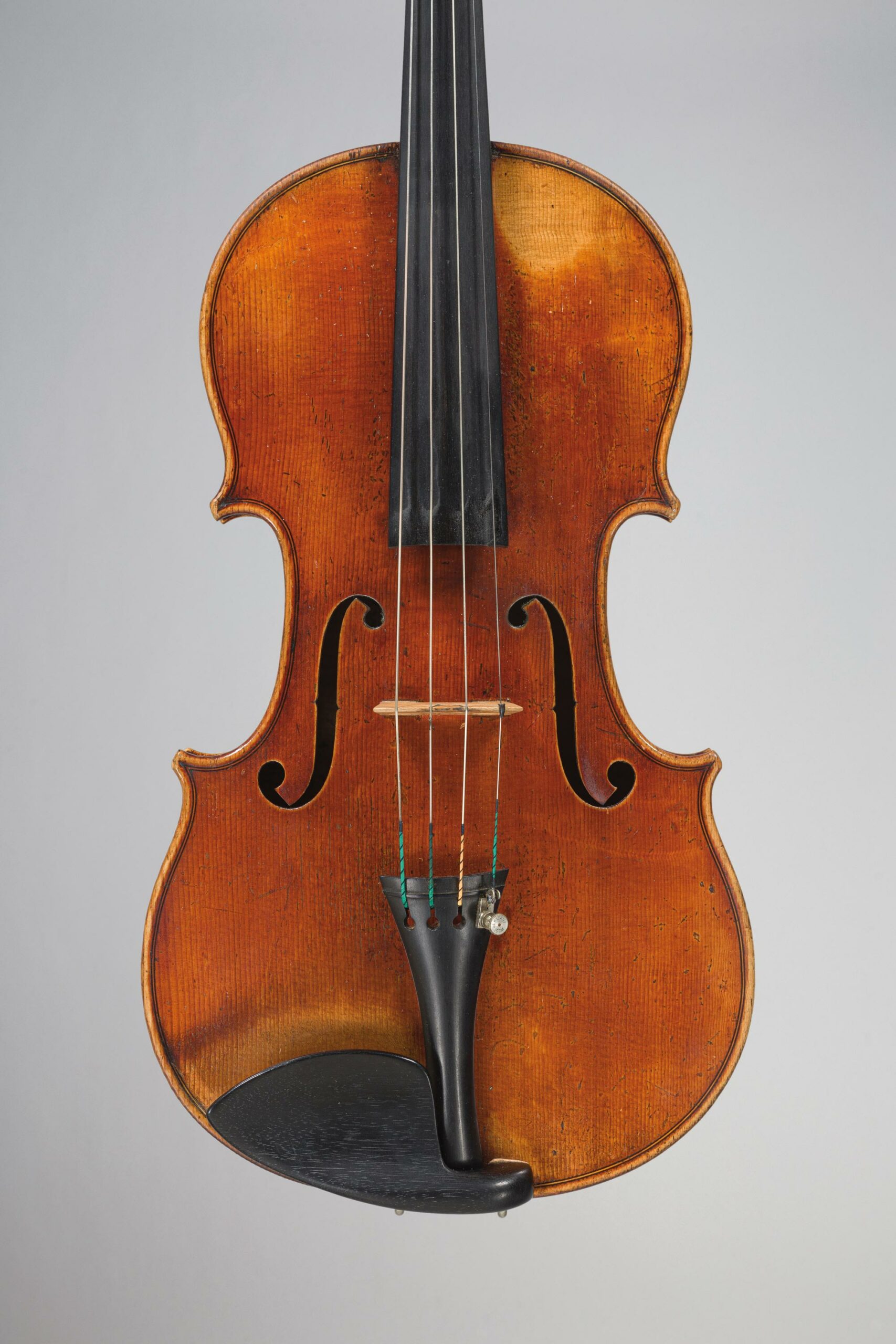
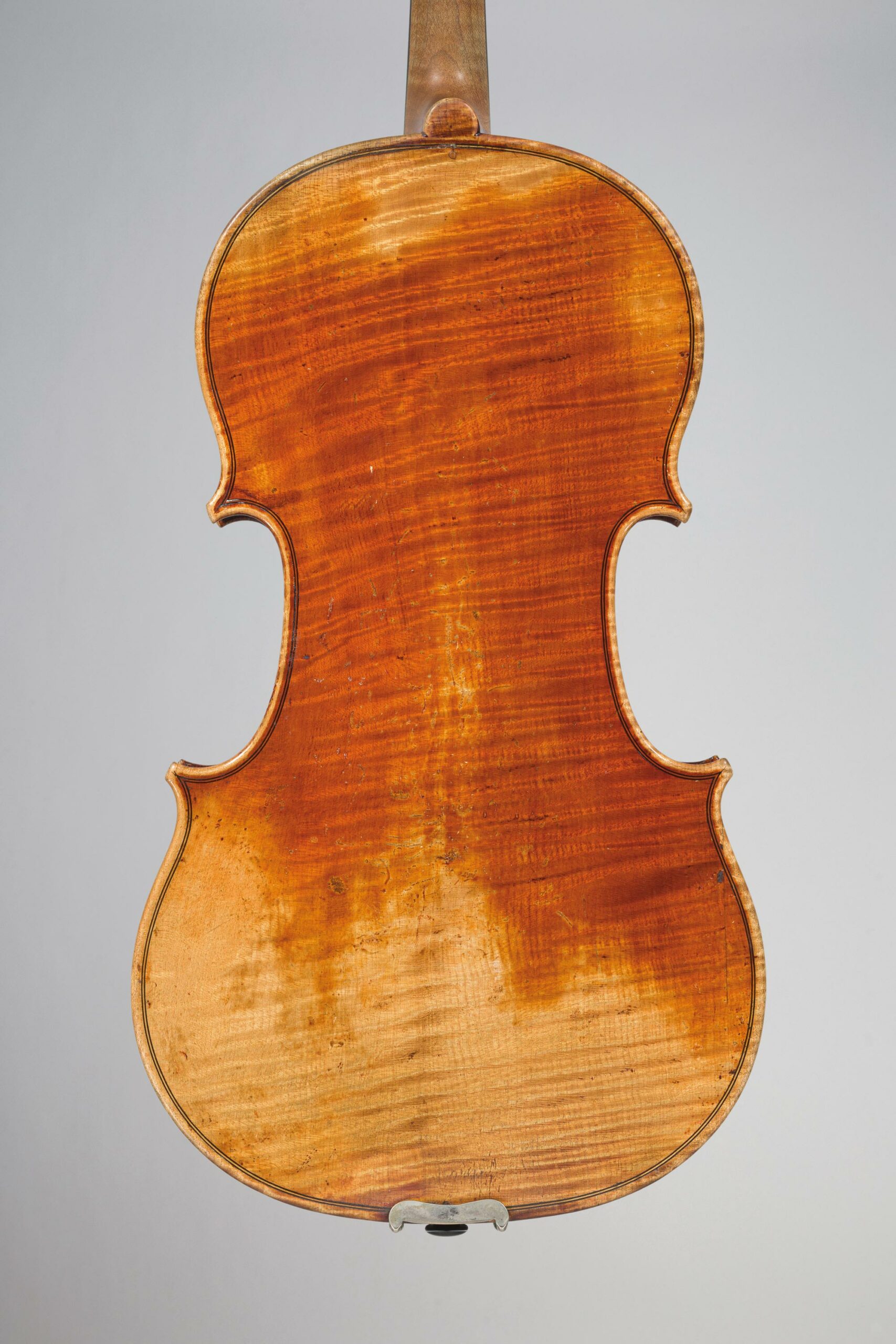
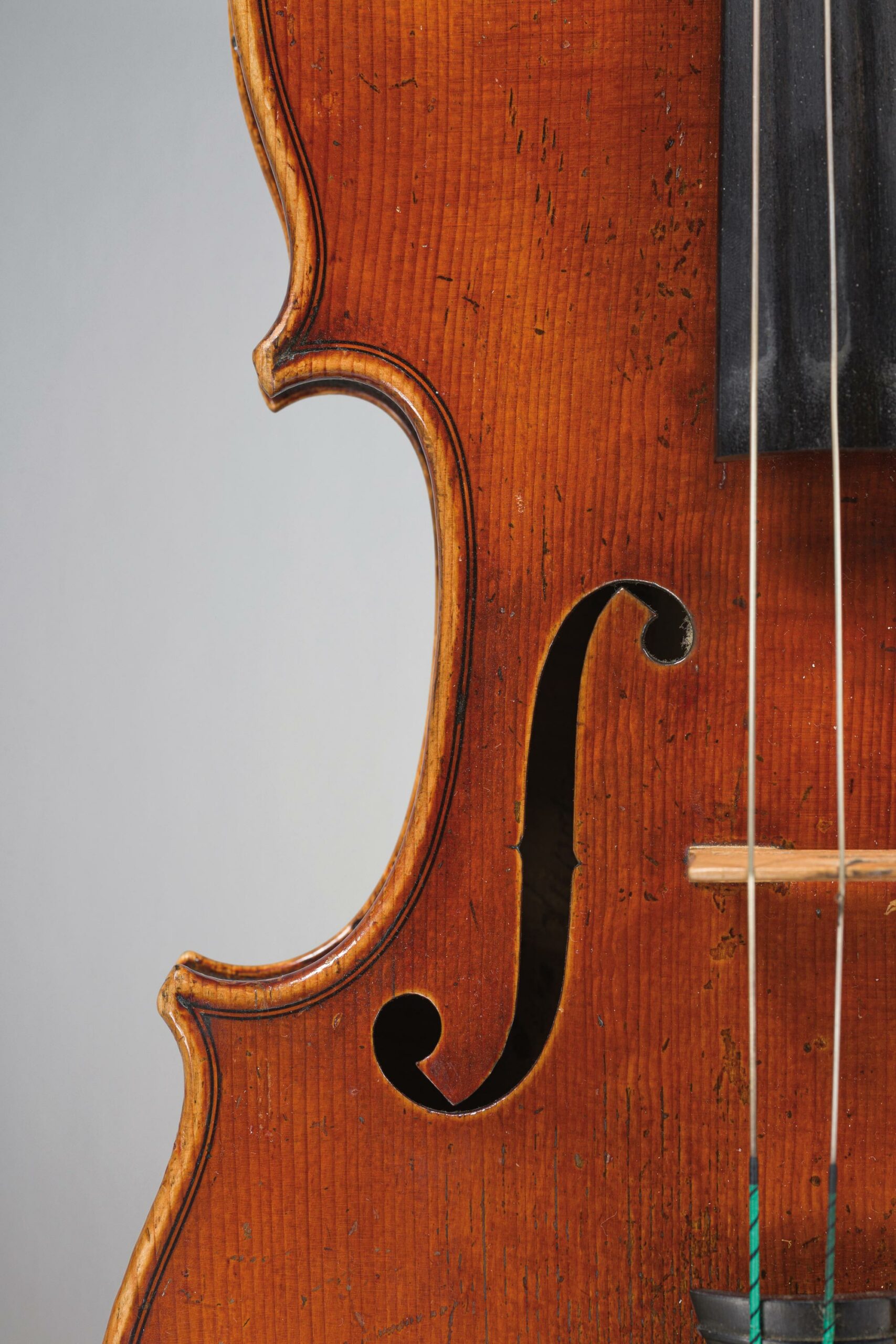
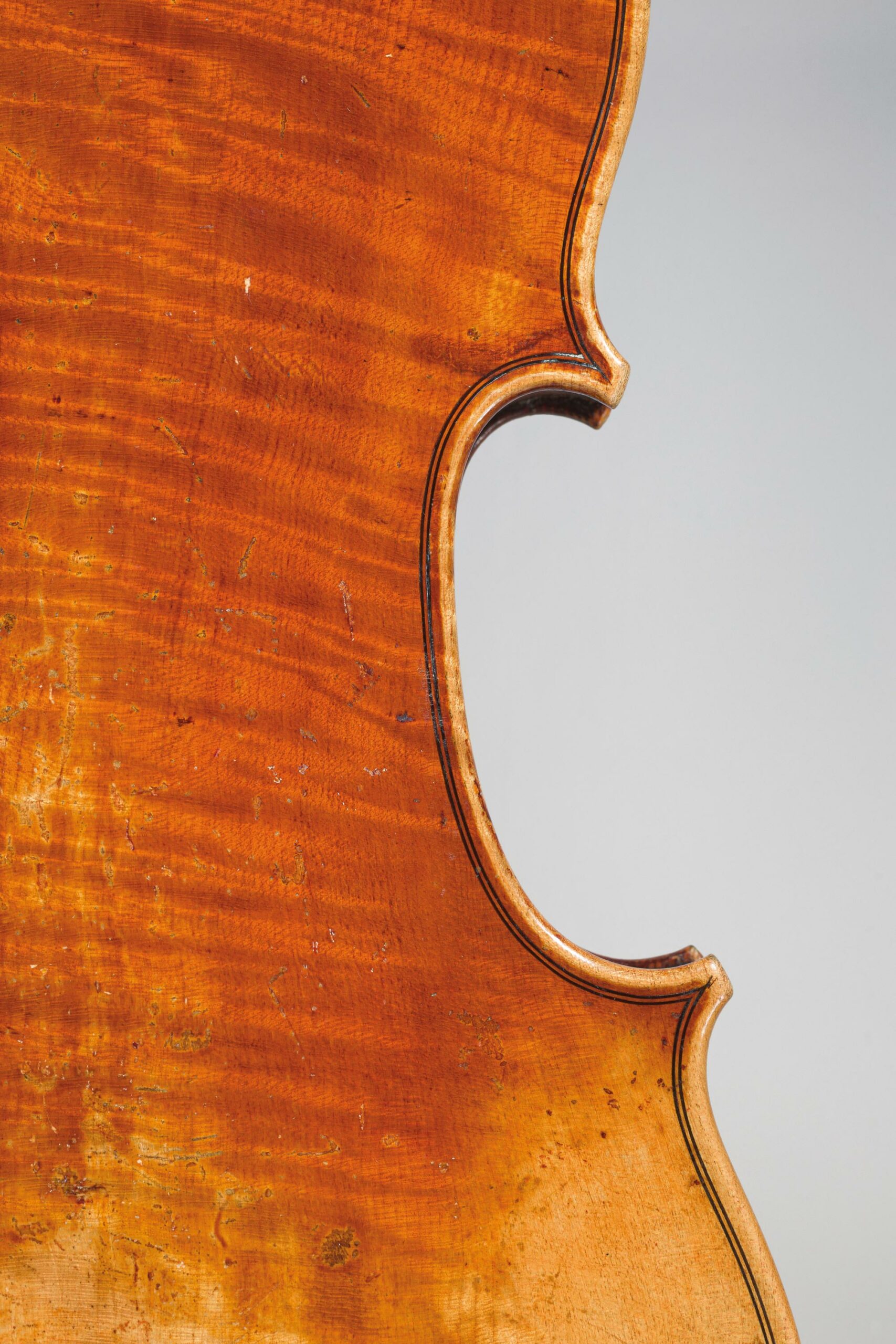
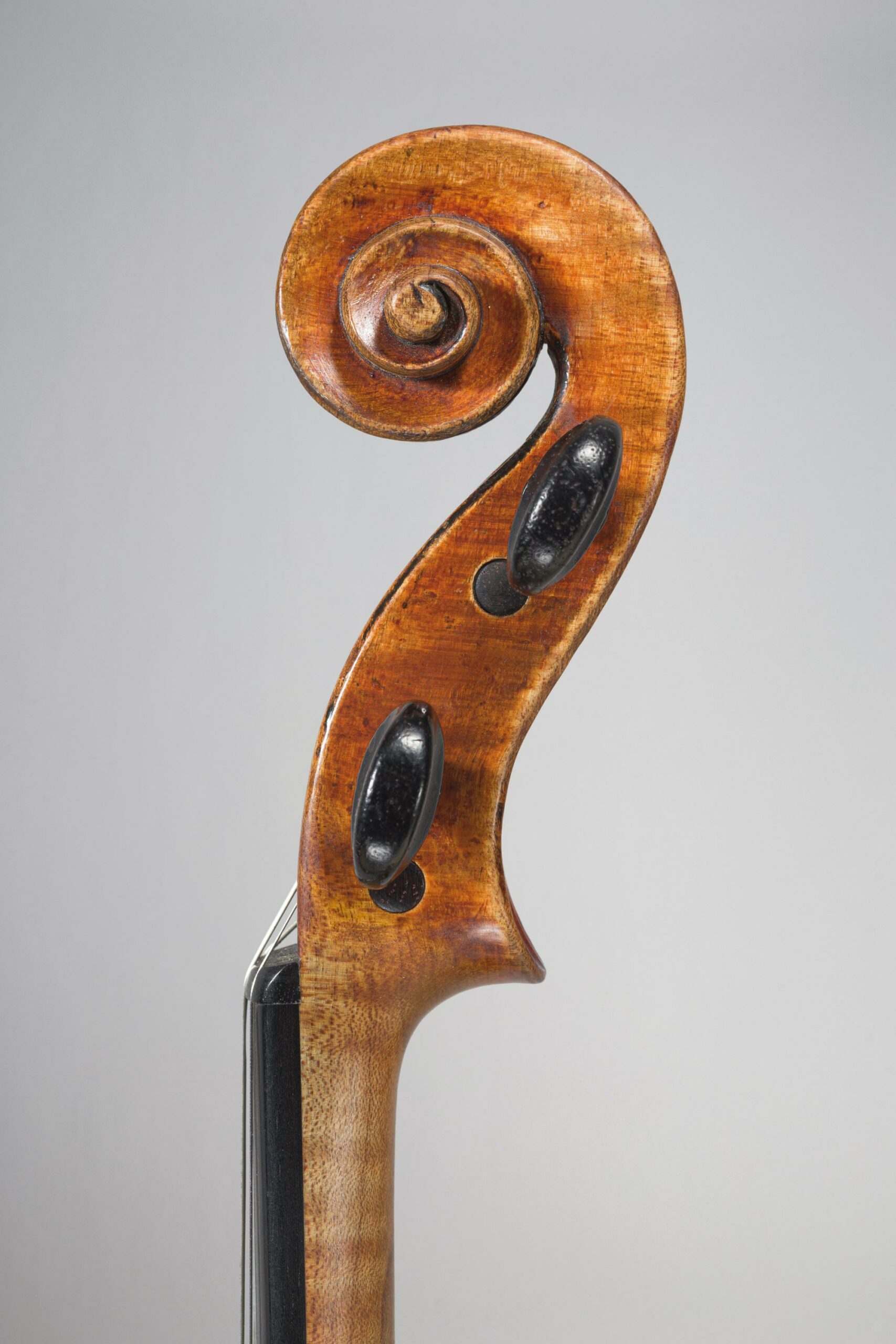
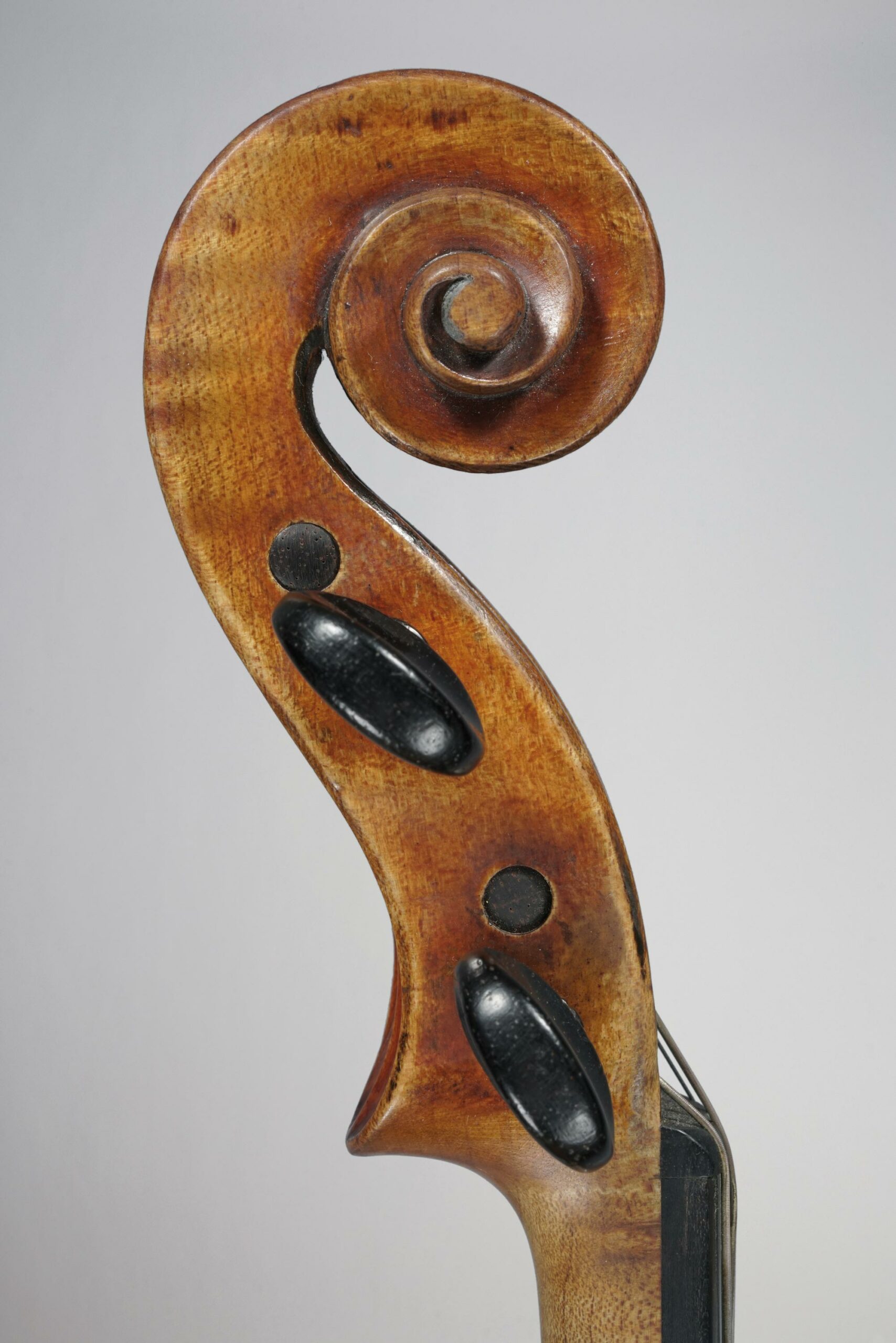
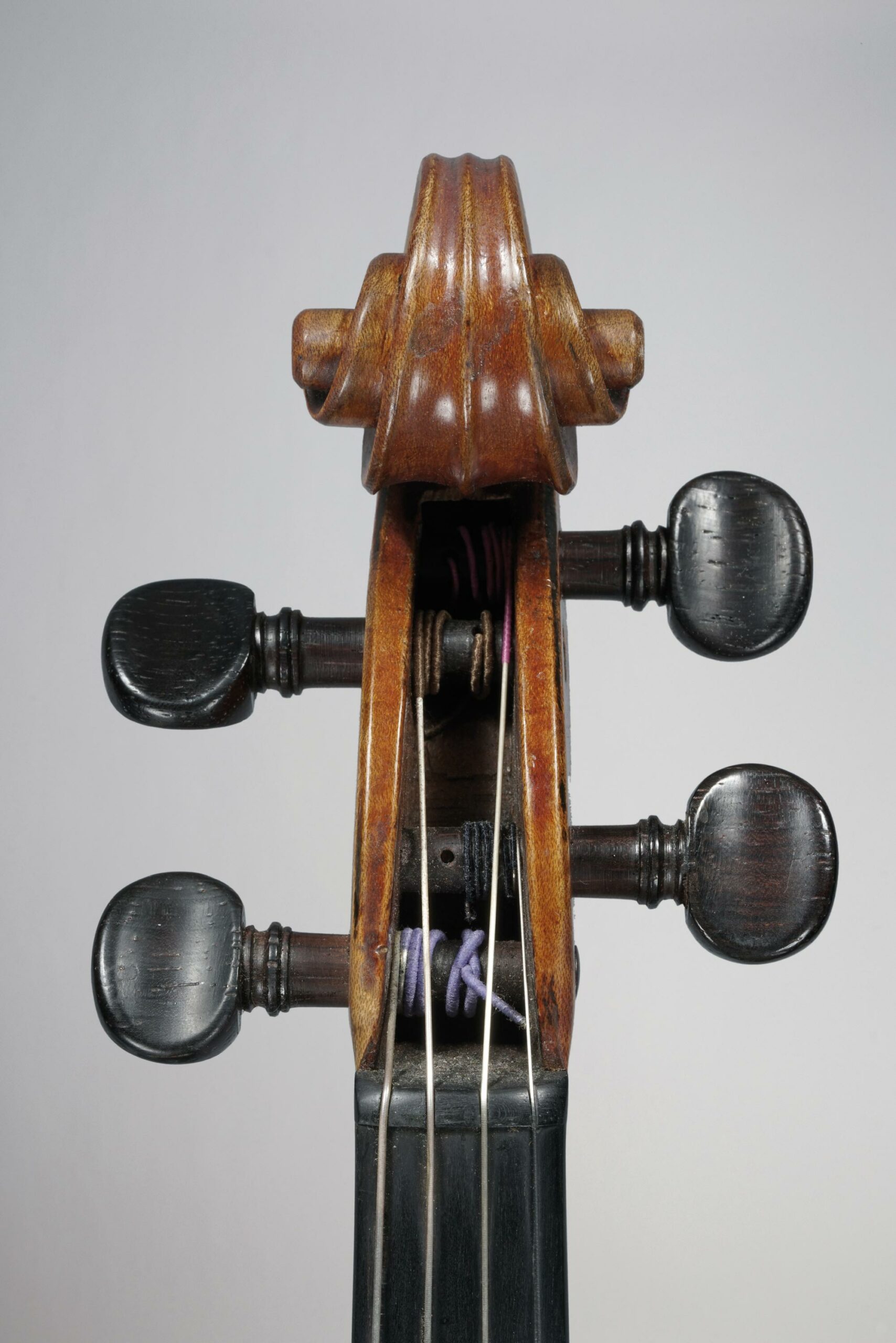

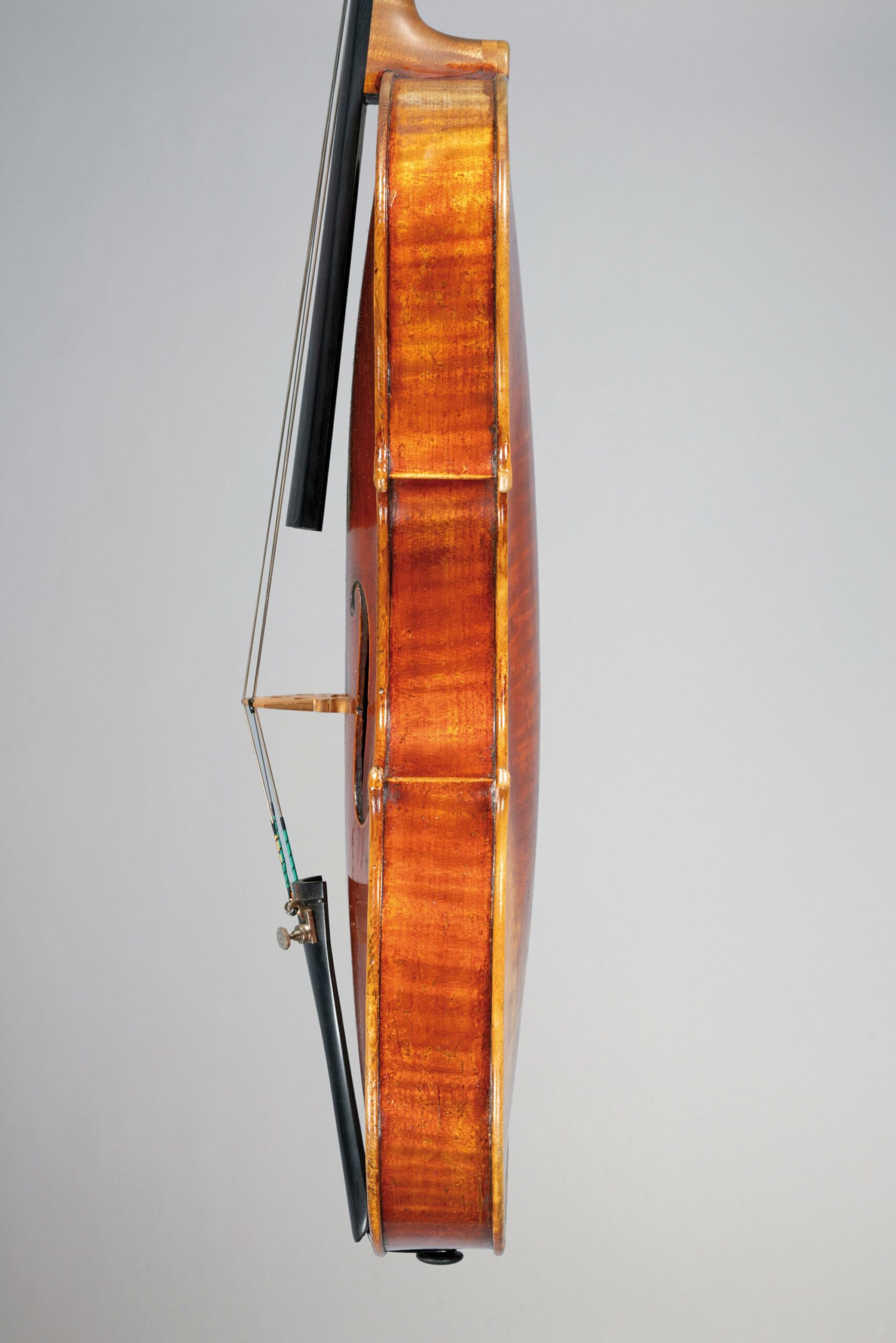
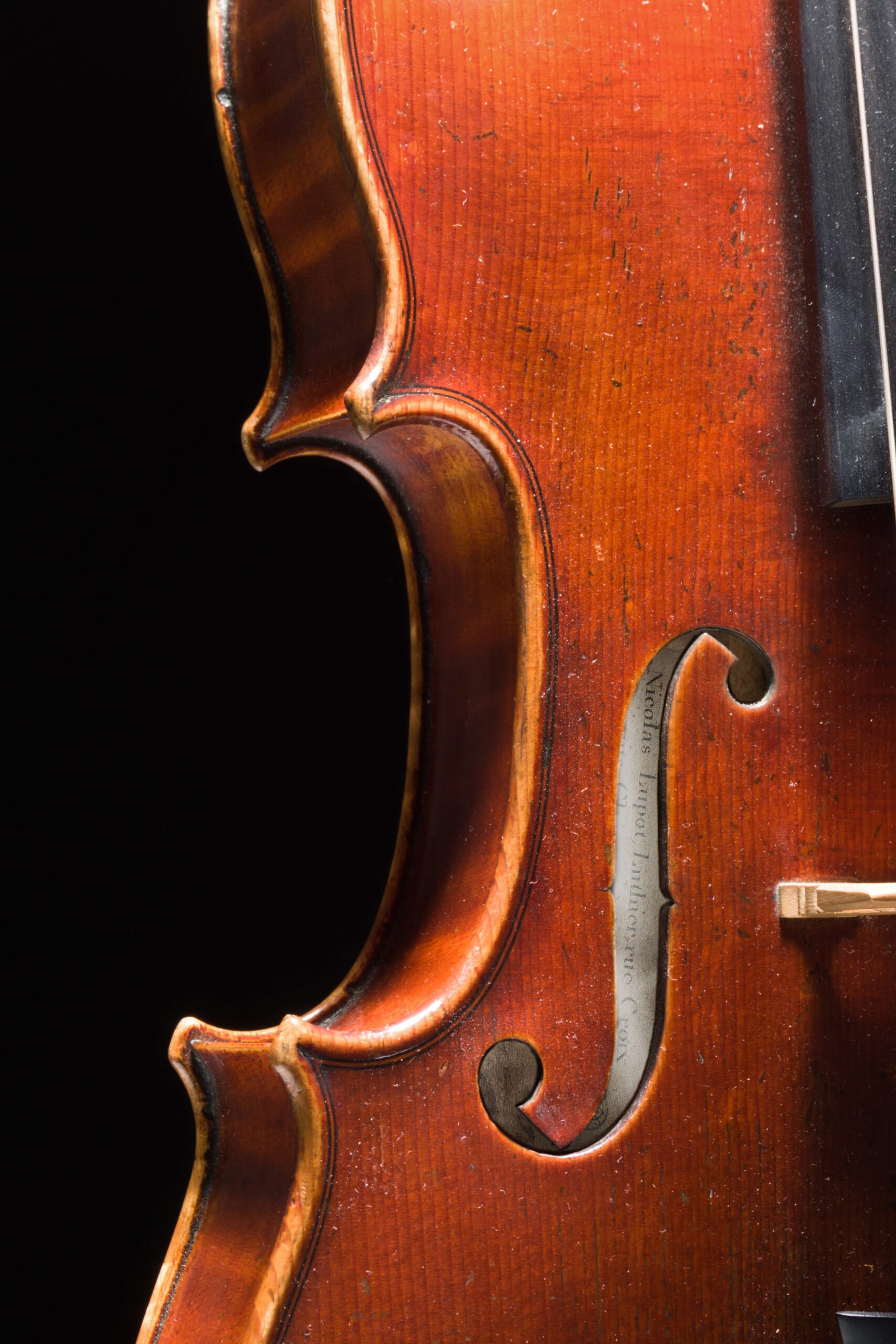
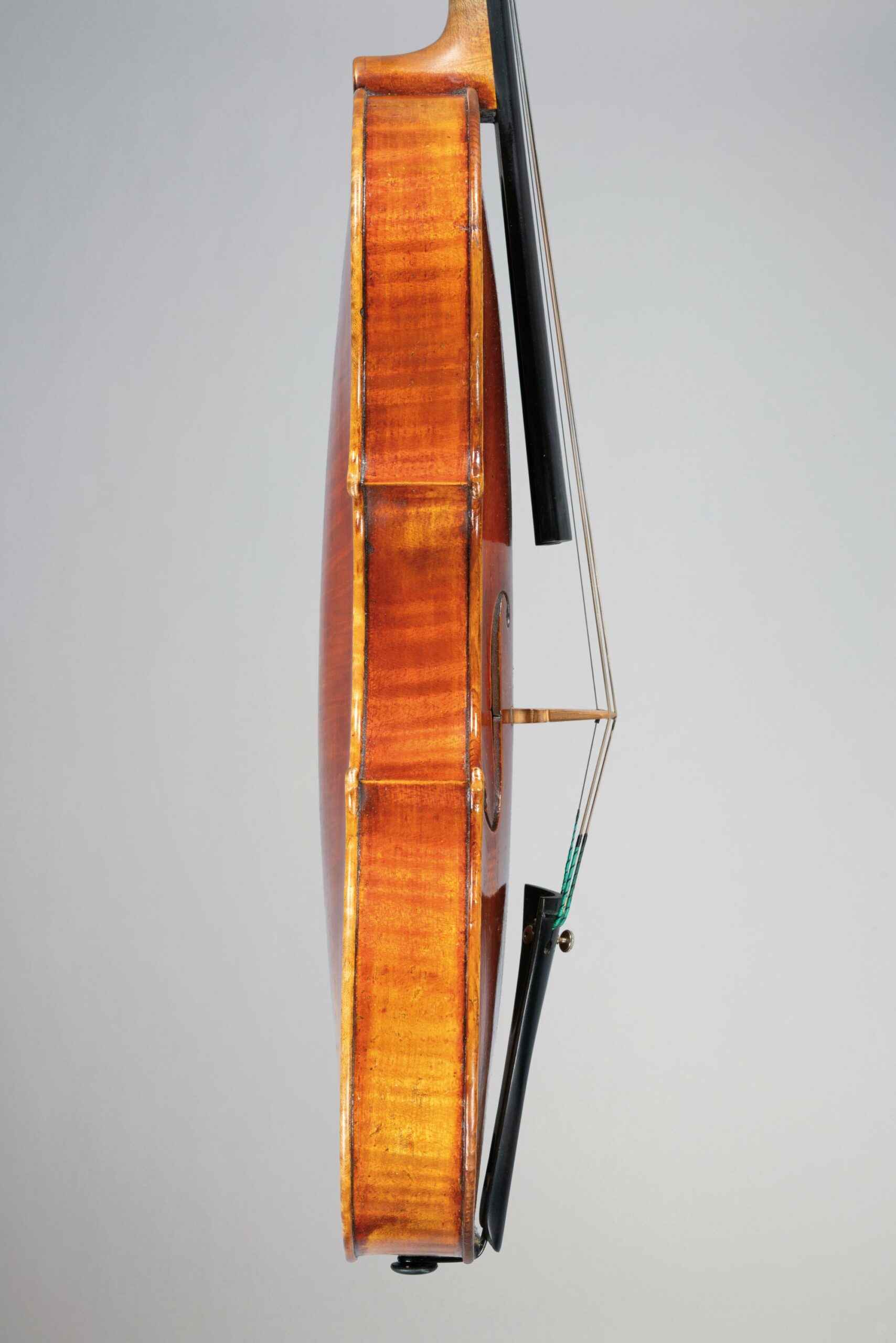
Alto de Nicolas LUPOT fait à Paris en 1808
Instrument mis en vente par Vichy Enchères le 1 juin 2023 © C. Darbelet
Lors d’une conférence donnée en l’an 2000, le luthier bâlois Roland Baumgartner (né en 1950) présente ainsi cet instrument :
« On connait peu d’alto de Nicolas Lupot. Cet instrument de 1808, est à ma connaissance, le meilleur exemple qui soit. Il porte son étiquette originale et la signature du maître, et a appartenu à mon ami et collègue Pierre Vidoudez de Genève. La longueur du corps est de 39,7 centimètres, le vernis est d’un aspect très attrayant, mais aussi très délicat au toucher. On peut imaginer que les grands classiques crémonais était encore préservés à cette époque, avec beaucoup de vernis, aussi le luthier des années 1800 se fixait-il pour but de créer des instruments similaires. Les filets sont en ébène pour le noir et en érable pour le blanc. »
Article de Roland Baumgartner édité par la Violin Society of América en 2000.
Cet instrument rare va sans aucun doute susciter de belles enchères lors de la vente prochaine, car on ne voit pas souvent passer de violons de la belle période de Lupot, et encore moins un alto du plus grand luthier français. De belles émotions en perspectives !
BIBLIOGRAPHIE
Hart, Georges : Le violon, ses luthiers célèbres et leurs imitateurs. Traduit de l’anglais par A. Royer. Paris, J. Rouam et Cie, éditeurs. 1886.
Henley, William : Universal dictionnary of violin and bow makers. Brighton, Amati publishing LTD. 1973.
Lutgendorg, Willibald : Die Geigen und Lautenmacher von Mittelalter bis zur Gegenwart. Frankfurt am Main, Frankfurter Verlag-Anftalt A.G. 1922.
Milliot Sylvette : Nicolas Lupot, ses contemporains et ses successeurs. Messigny et Vantoux, JMB Impressions, 2015.
Sibire, abbé : La chélonomie ou le parfait luthier. Bruxelles, A. Loosfelt, Libraire. 1885.
Vannes, René : Dictionnaire universel des luthiers. Spa, Les amis de la musique. 1999.
Vidal, Antoine : Les instruments à archets. Paris, Imprimerie de J. Claye. 1876.
On consultera avec grand profit le magnifique ouvrage collectif « Nicolas Lupot » publié en 2017 par l’A.L.A.D.F.I., dans lequel de nombreuses photographies d’instruments sont données à l’échelle 1.
A magnificent viola by Nicolas Lupot will be auctioned on 1 June 2023 in Vichy. The Basel-based violin maker Roland Baumgartner said during a conference in 2000: “We know of few violas by Nicolas Lupot. This 1808 instrument is, to my knowledge, the best example there is.”
An article by Lothaire MABRU
Professor Emeritus, University of Bordeaux Montaigne


Let’s take a look at the 1805 painting by Henriette Lorimier (1775-1854) showing Nicolas Lupot in his workshop. The maker takes centre stage, and we hardly notice the presence of certain objects intended to show the social status of the craftsman, except maybe his clothes which suggest a certain financial wealth. What is significant here is a triangle (a possible reference to the Freemasons) formed by his two beautiful hands, with long and thin fingers, and his face. His demeanour conveys a sense of concentration, while at the same time being that of a man who is content and passionate about his job. One of his hands holds a finished violin, being tuned, and which is the object of all his attention. His right hand holds a tool, and in front of it, on the workbench, a soundpost, a compass, and a tuning fork complete the portrait. Everything is there, and nothing is superfluous: we go straight to what’s essential. This is what gives charm and elegance to this painting, including the black background that reinforces the presence of the maker.
Lupot was the tutor of Charles François Gand (1787-1845), who later became his successor. A second painting, of the same year as the first one, portrays Gand aged 18. It is reasonable to assume that Lupot took advantage of the presence of Henriette Lorimier in his workshop to ask her to paint the portrait of the pupil he already considered his best.
Lupot is none less than the greatest French violin maker, not only of his time, but of all time. This earned him the nickname of “French Stradivarius”. This compliment still relegates him to second place, as it implies that the unsurpassable Cremonese maker will forever be the ne plus ultra of the craft. However, Lupot was not a mere copyist of Stradivarius, and although he had a great admiration for this master, he infused his instruments with his own personality and, rather than just copying instruments, he extracted what constituted the essence of the maker’s work.
Although Lupot was born in Stuttgart, his family was originally from Lorraine, as was often the case with French violin makers, and he was born into a family of makers, with his grandfather Laurent (1696-1771), and subsequently his father François (1725-1805), both in the profession. The latter would come to be known as François I because Nicolas had a brother – also named François and known as François II (1774-1838) – who was a renowned bow maker. François I, who was established in Lunéville, felt the wind of change and seized on an opportunity to leave in 1758 for the court of the Duke of Württemberg in Stuttgart, where he held the position of luthier of the court. This is where Nicolas was born on 4 December of that same year. Ten years later, the duke’s lavish expenses, as well as his affairs with court singers, caused a scandal and he had to dismiss his staff.
As a result, François I’s position was terminated, and he moved to Orléans, where a few years later Nicolas would in turn become a violin maker. This is where he learned his craft, first as apprentice to his father, and then as his workman.
The violins of Lupot pere follow mainly the Stainer model, which was popular at the time. However, he came across Stradivari instruments at the court of Stuttgart, and towards the end of his career, the instruments he made with his son began to show the influence of the famous Italian master, an influence that would be even more pronounced in the instruments produced later by Nicolas; the process that would lead to the masterpieces of the son much later was underway.



Violon de François LUPOT fait à Orléans vers 1775-1780
Instrument mis en vente par Vichy Enchères le 5 décembre 2013 © C. Darbelet





Violon de François LUPOT fait à Orléans vers 1775
Instrument mis en vente par Vichy Enchères le 3 juin 2004 © JH Bayle
Lupot eventually settled on his own rue d’Illiers, in Orléans, in 1781. He remained there until 1796, the year he moved to Paris. In his first period, the maker initially followed in the footsteps of his father. However, from 1792, he started collaborating with Louis François Pique (1758-1822), who focused his attention on Stradivarius. Lupot had to up his game, as Pique ordered from him violins in white, which the latter varnished and labelled.
This type of arrangement forces the subcontractor to follow the model and instructions of his employer; otherwise, the latter would not accept to claim it as his work by inscribing his name in it. This experience allowed Nicolas Lupot to move towards producing instruments in the style of Stradivarius, who was becoming more influential for Parisian violin makers, while the influence of Stainer and Amati was fading. In other words, Lupot freed himself from the past and became aware of his abilities.





Violoncelle de Nicolas LUPOT fait à Orléans vers 1792/1793
Instrument mis en vente par Vichy Enchères le 3 décembre 2009 © Maison Vatelot Rampal
Dutch violinist Myrthe Helder, who plays on a late 18th century Lupot violin, describes it as follows:
« I’ve played on many instruments in my life, but it’s only now that I feel like I’ve found my soulmate. This Lupot is a clear, big, strong violin, but also very beautiful and poetic. It possesses amazing qualities, easily rising above an entire orchestra (…). I’ve had Stradivarius violins in my hands and I still prefer this Lupot! ».
The move to Paris allowed Nicolas to develop his knowledge by rubbing shoulders with the best musicians who played on great quality and beautiful violins. He examined and analyzed the instruments, taking notes and incorporating the knowledge he acquired into his own making. But he wanted to go further, by publishing a summary of his findings.
This was achieved thanks to the abbot Sibire who published in 1806 “La Chélonomie ou le parfait luthier”, based on the writings of Nicolas Lupot, who is not credited, but who is nonetheless the true author of the book, the abbot having merely edited and formalised his written notes. Sylvette Millliot rightly considers this publication as “a real aesthetic revolution”. (2015, vol. 2 p. 32).





Violon de Nicolas LUPOT fait à Paris au millésime de 1804
Instrument mis en vente par Vichy Enchères le 3 juin 2010 © Maison Vatelot Rampal
As for the omission of the maker’s name as author of the book or in the body of the text, one can only wonder…
« Was it out of extreme modesty that the skilful violin maker did not wish to be named on the cover of the book? Was he concerned that, in declaring himself the author, the public would condemn the work without reading it and consider it a work of narrow, personal views, or as an advertisement for a maker? By only including the name of Abbé Sibire, did he want to give the book a broader, more general, less individual scope, in other words, was he looking for, by this innocent and very excusable subterfuge, to evade bouts of jealousy, rivalry and hatred, for if Lupot had his friends and his admirers, he also had, alas, his enemies and detractors?
All these assumptions are reasonable, but the last one seems the most plausible. Lupot was a scholar, a thinker, a restless inventor, and, like all men who seek and who find, he was up against strong opposition from the mediocre and those opposed to change ».
These are the words of the author of the introduction to the 1885 edition, L. de Partis, which gives us an insight into the personality of the maker.
Success came inevitably, as evidenced by the fact that from 1797 the Conservatoire commissioned a violin from him to be offered as first prize, a tradition which was permanently established from that point on and continued with Gand, and Gand et Bernardel, the successors of Lupot.
The move of Nicolas Lupot’s workshop to rue Croix-des-petits-Champs marked the beginning of what is referred to as the golden period of the maker, during which he made his most beautiful instruments, until the very end, when old age was making itself felt, and his hand slowed down and became a little heavier. Charles François Gand left him in order to return to Versailles, and he then took over from Koliker in Paris in 1819, and finally in 1824, from Lupot himself, his master and father figure.
The official awards and recognition kept pouring in, and in 1813 he received the title of “Luthier of His Majesty the Emperor”, and then that of “Luthier of the Royal Chapel of his Majesty the Emperor and the King”. Obviously, these titles and positions were not granted lightly, and they crystalized the high regard for his work.
Not content of producing the best and most beautiful instruments of his time, Lupot also inaugurated a “school of violin making” which operated throughout the 19th century. He trained Silvestre, Gand but also Bernardel Père, who themselves passed on their knowledge to their sons, who, subsequently, joined forces and established Gand et Bernardel, and in doing so perpetuated throughout the 19th century the tradition initiated by Lupot. In other words, the achievements of Nicolas Lupot cannot just be measured by his instrument making, even though that in itself would account for a lot: he can also be credited with allowing French violin in the 19th century to overtake the Italian one, which was in decline at that time. It is generally accepted that if Italian violin making dominated the 18th century, the 19h century belonged to the French.
Un magnifique violon de 1811
John Dalley du fameux quatuor Guarneri, en compagnie de Michael Tree, David Soyer, et Mikhail Rudy, joue le quatuor en sol mineur de Brahms. John Dalley tout comme ses confrères du quatuor Guarneri, s’est vu proposer un Stradivarius. Ils ont tous refusé !
There is no shortage of glowing comments about Lupot from musicians and music book authors from around the world. That of German composer, virtuoso violinist and teacher Ludwig Spohr (1784-1859) allows us to understand the esteem in which Lupot’s instruments are held. In his Violin Method of 1832, he placed the instruments of Pique and Lupot on an equal footing with those of Stradivarius, Guarnerius and Amati. In his Dictionary of Violin Makers, Willibald Lutgendorf writes about Spohr: “Since buying a Lupot violin, he plays exclusively on it“. (1922, p. 307)
For Antoine Vidal, Lupot is the pioneer and leader of 19th century French violin making. “Throughout the 18th century in France, only second-class instruments were produced; and, until the moment when Nicolas Lupot came to settle in Paris, we very much remained in an inferior position. But when he began to work in earnest, a new dimension opened up for us, and it signalled the advent of the golden era of French violin making, which has kept on developing to this day.” 1876, first volume p. 152.
The Englishman Georges Hart confirms this point of view: “Lupot had no rival in his time; no one since him has been able to match his productions. Let’s say it boldly, Lupot is the king of modern luthiers, and his instruments only get better as time goes by. His varnish is very particular to him. It is of good quality and of a delicate texture. Although it does not emulate the Italian varnish, it also moves away from the type of varnish found on the violins of his contemporaries; it can therefore be defined as a varnish that takes the centre ground between the Italian and French varnishes. Its colour varies from light red to brown red. Time has increased its shine, and although it is true to say that it will never surpass the varnishes of Cremona, it will nevertheless hold the first place among modern varnishes.” (1886, p. 211-212).
Moreover, it should be said that Nicolas Lupot still holds this first place to this day. Indeed, these praises live on in more recent publications. William Henley wrote about him in his dictionary, that he “became the greatest French genius” (1973, p. 727), and René Vannes, also the author of a dictionary of violin makers that has become a reference, does not hesitate to say that “his work leaves nothing to be desired; the craftsmanship is perfect and cannot be surpassed. The sound [of his instruments] is beautiful, not very bright, but full and projecting well”. (1999, p. 219).
This beautiful viola by Nicolas Lupot, dated 1808, and therefore from his so-called golden period, is typical of his work at that time. The instrument is coated in an orange-red varnish over a yellow ground, which must have greatly pleased the successive musicians who have played it, as the yellow varnish appears in many areas of the instrument. The back is in one piece of maple with medium to narrow figure, rising from left to right. Two pins, inserted through the back into the top and bottom blocks, consolidate the body and appear like two moles on this viola. On the front we notice the purfling fluting in the corners ending in “crow’s beaks”, which not only show the steady hand of the maker, but also confers additional charm to the instrument. The one-piece front has a slight wavy pattern, particularly prized by Lupot, and which, according to acousticians, confers a certain sound quality. The model is strongly inspired by Stradivarius – as is often the case with this maker – but remains personal. The head, which is in the violin style and not the cello one (with offset) as is often the case for violas, features a profile of rare elegance.
This viola, which was until recently played in a symphony orchestra and chamber music ensemble, was previously the property of Swiss luthier Pierre Vidoudez (1907-1994), who, in his spare time, used to play it for his personal enjoyment, hence its name of “ex-Vidoudez”. It was attributed the name of a previous famous owner, as is often the case with high quality bowed string instruments.
The Vidoudez workshop in Geneva has been in existence since 1904, the year in which Alfred Vidoudez, father of Pierre, set it up, having previously trained in the French school of making by G. Bazin, Mougenot and L. Bernardel. Pierre took over his father’s workshop in 1943, after training in Mittenwald and then with Boulangeot in Lyon, but also in various workshops in Markneukirchen, and he completed his training learning restoration with Caressa in Paris. Just like his father, he received the title of “Luthier du Conservatoire de Genève”. His instruments, inspired by the Cremonese masters, have received awards for their sound.











Alto de Nicolas LUPOT fait à Paris en 1808
Instrument mis en vente par Vichy Enchères le 1 juin 2023 © C. Darbelet
During a conference in 2000, the Basel-based luthier Roland Baumgartner (born in 1950) introduced this instrument as follows:
« We know of few violas by Nicolas Lupot. This 1808 instrument is, to my knowledge, the best example there is. It bears its original label and the master’s signature, and belonged to my friend and colleague Pierre Vidoudez from Geneva. The length of the body is 39.7cm, the varnish is very appealing, and also very delicate to the touch. One can only imagine that the great classic Cremonese instruments were still in a great state of preservation at that time, retaining a lot of their original varnish, and so this maker of the 1800s took up the challenge of recreating these masterpieces. The purfling is of ebony for the blacks and maple for the whites. »
Article de Roland Baumgartner édité par la Violin Society of América en 2000.
This exceptional instrument will undoubtedly attract a lot of interest at the next sale, as violins, let alone violas, from the best period of Lupot, the greatest French violin maker, are rarely seen on the market. It will be an emotional moment!
BIBLIOGRAPHIE
Hart, Georges : The violin, its famous makers and their imitators. Translated from English by A. Royer. Paris, J. Rouam et Cie, publishers. 1886.
Henley, William : Universal dictionary of violin and bow makers. Brighton, Amati publishing LTD. 1973.
Lutgendorg, Willibald : Die Geigen und Lautenmacher von Mittelalter bis zur Gegenwart. Frankfurt am Main, Frankfurter Verlag-Anftalt A.G. 1922.
Milliot Sylvette : Nicolas Lupot, ses contemporains and ses successeurs. Messigny et Vantoux, JMB Impressions, 2015.
Sibire, abbé : La chelonomie ou le parfait luthier. Brussels, A. Loosfelt, Bookseller. 1885.
Vannes, René : Dictionnaire universel des luthiers. Spa, Les amis de la musique. 1999.
Vidal, Antoine : Les instruments a archets. Paris, Imprimerie de J. Claye. 1876.
We also recommend referring to the magnificent collective work “Nicolas Lupot” published in 2017 by the A.L.A.D.F.I., which includes many actual size photographs of instruments.